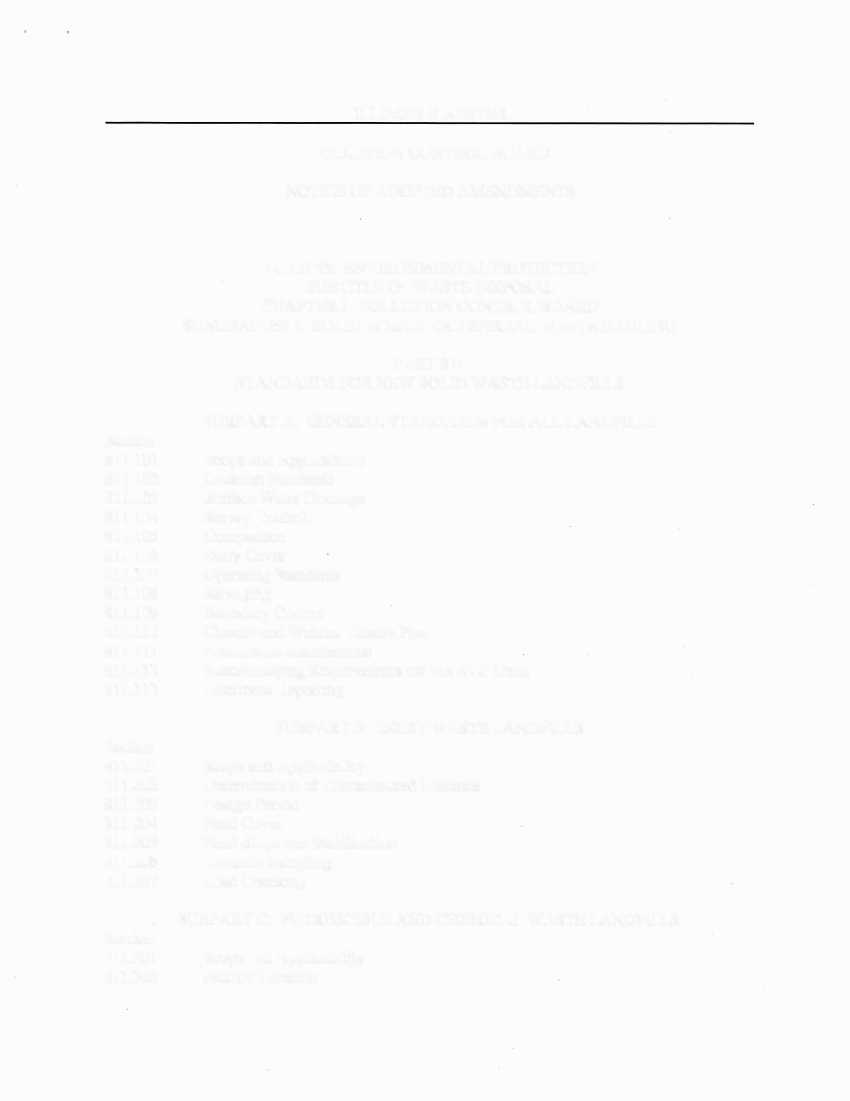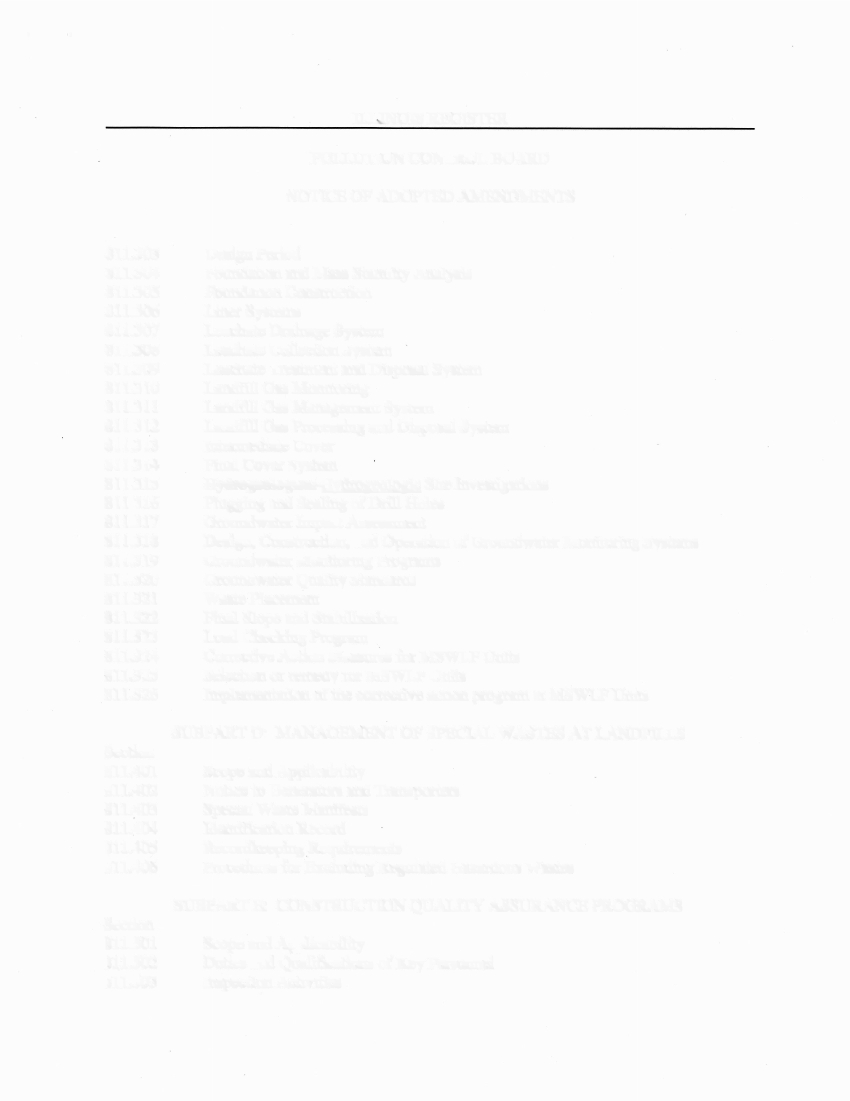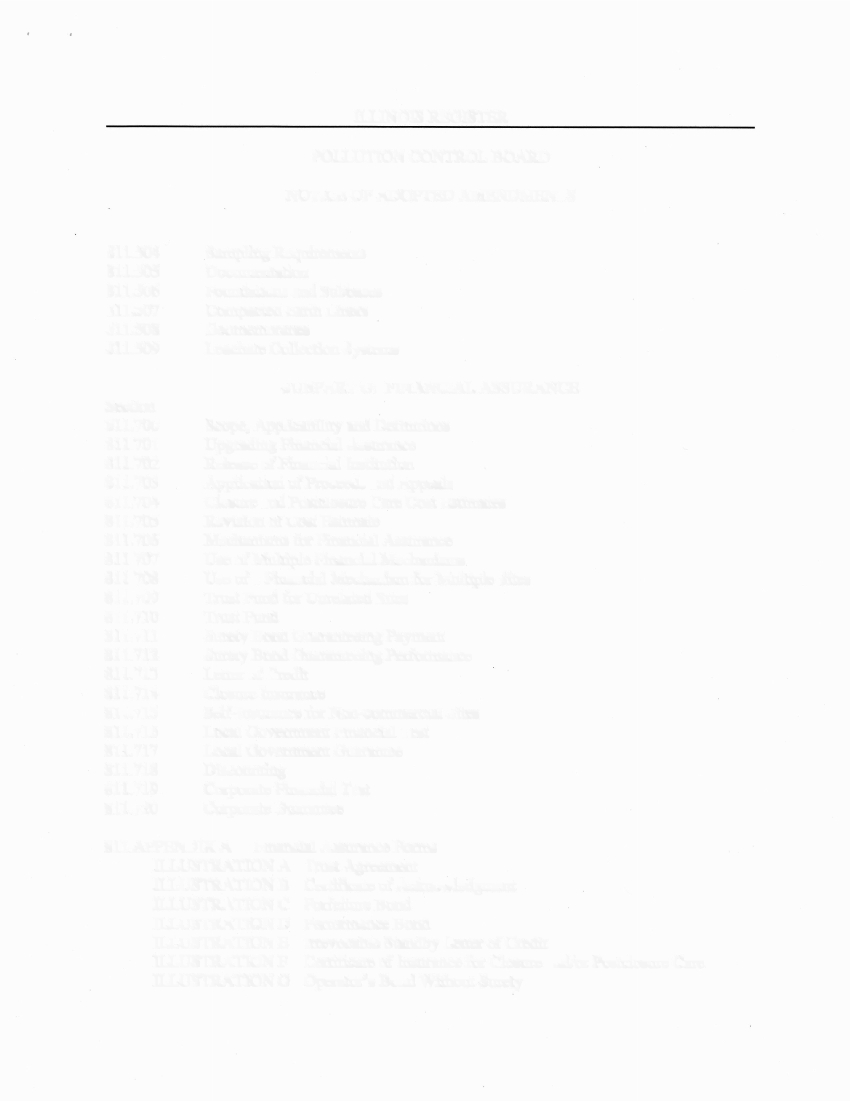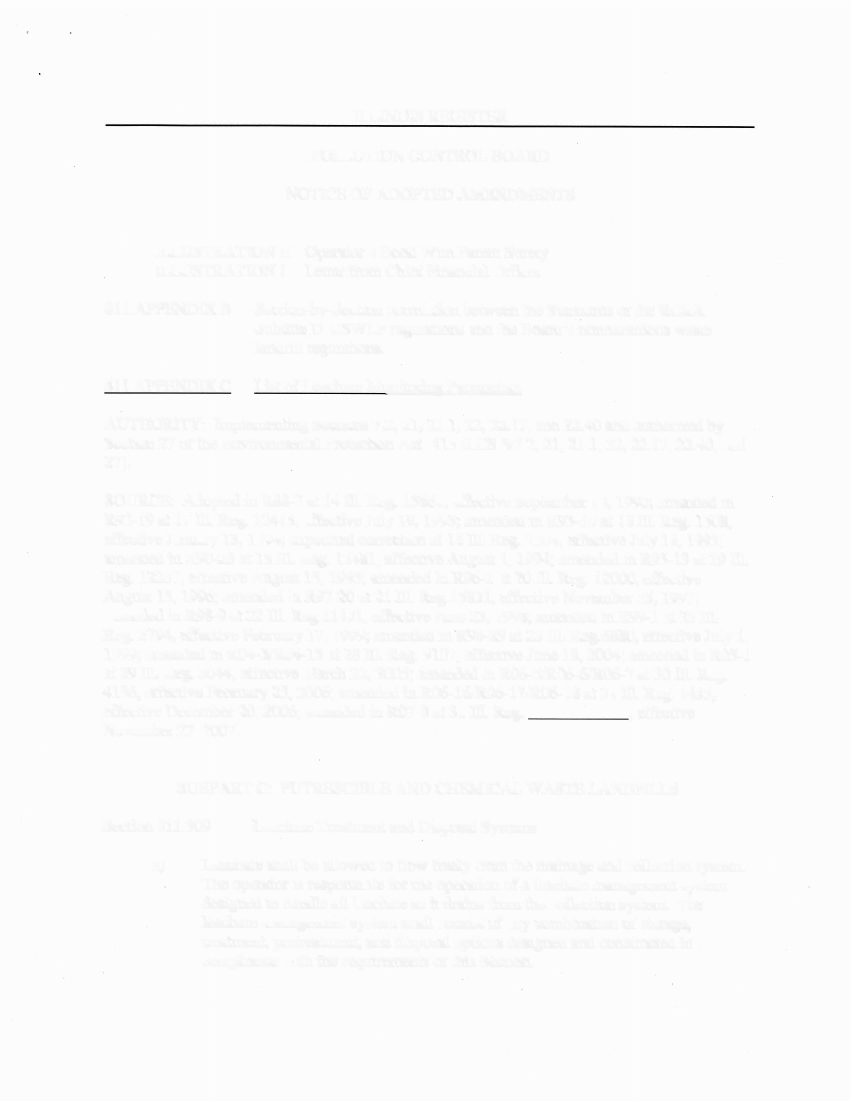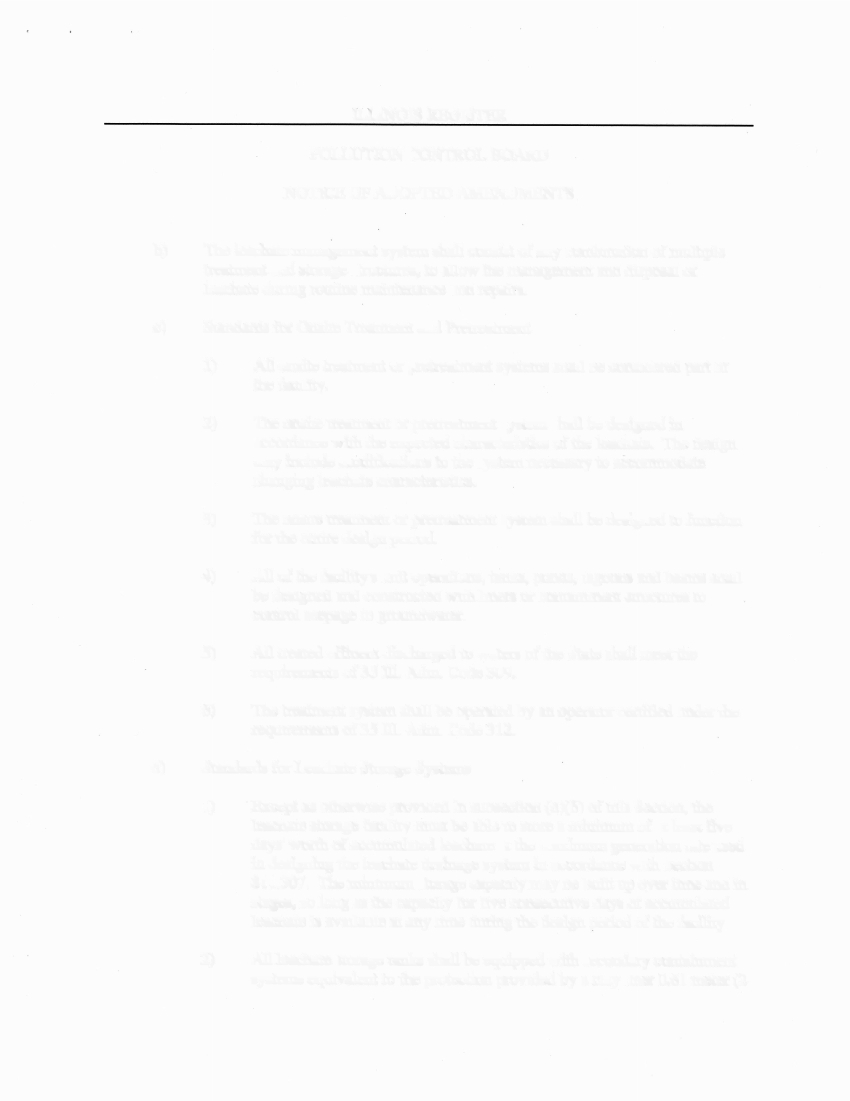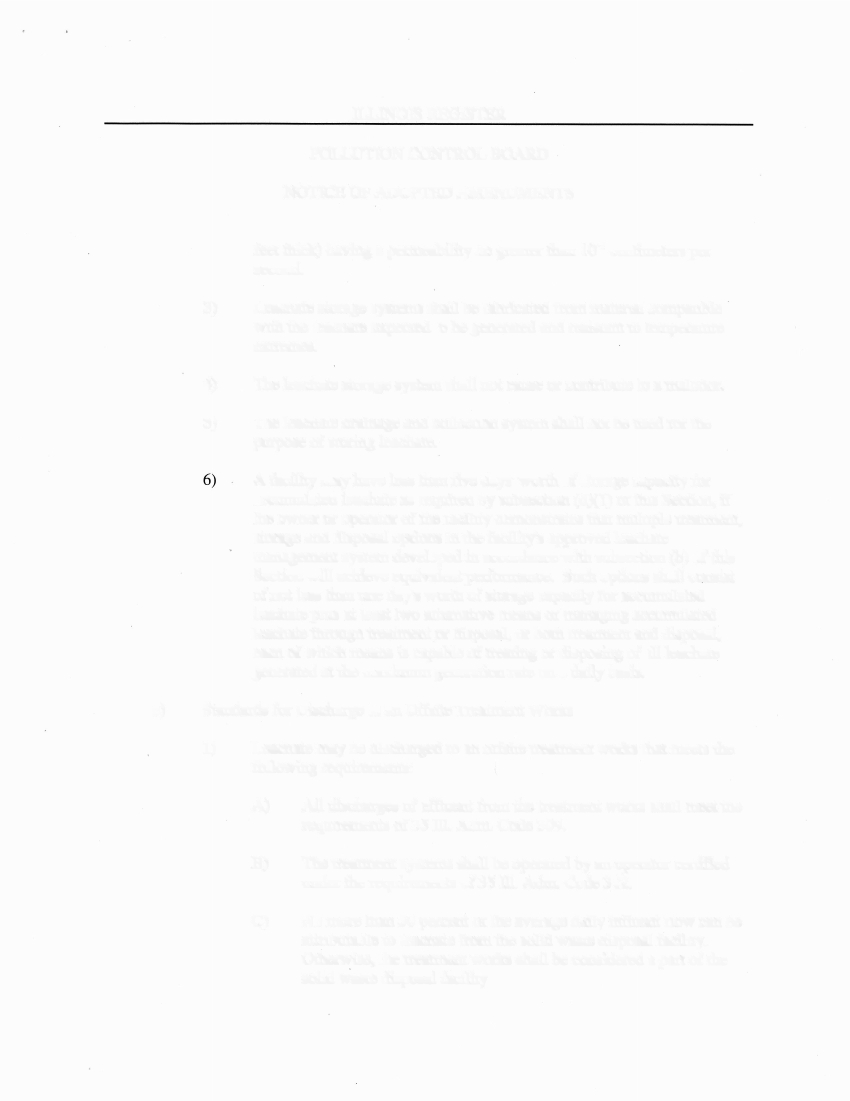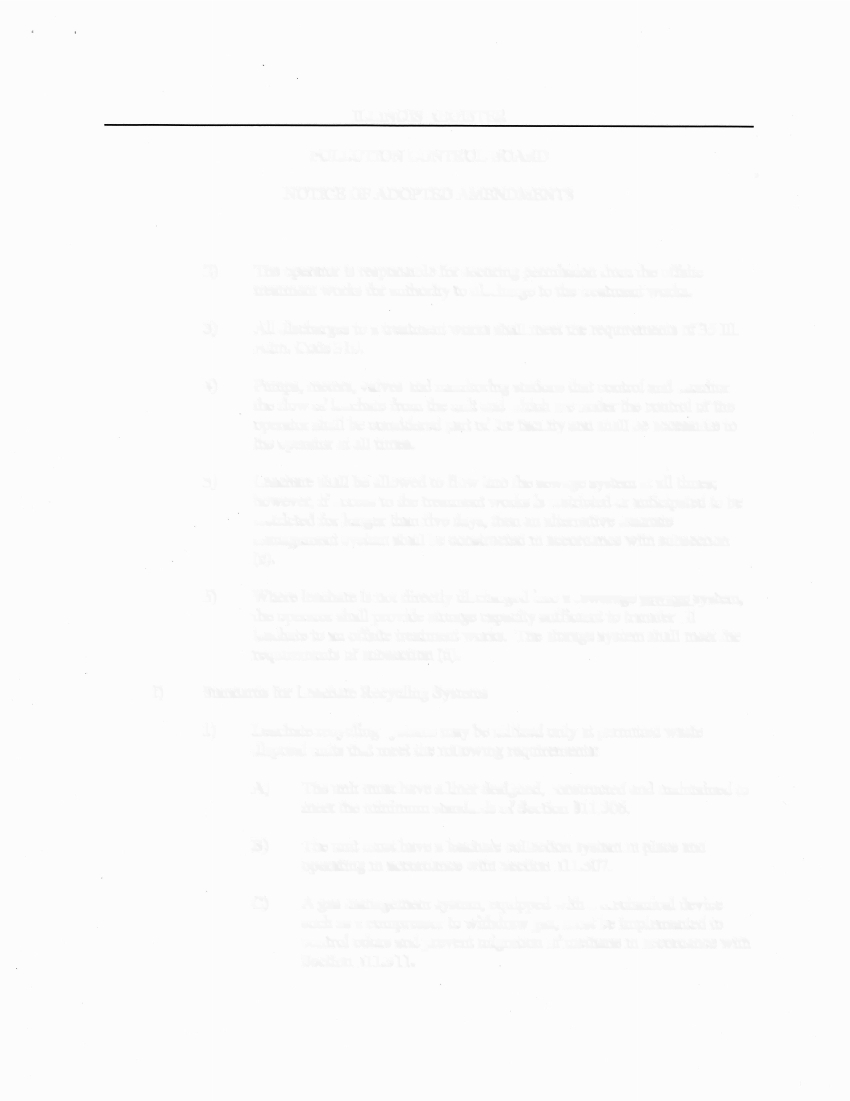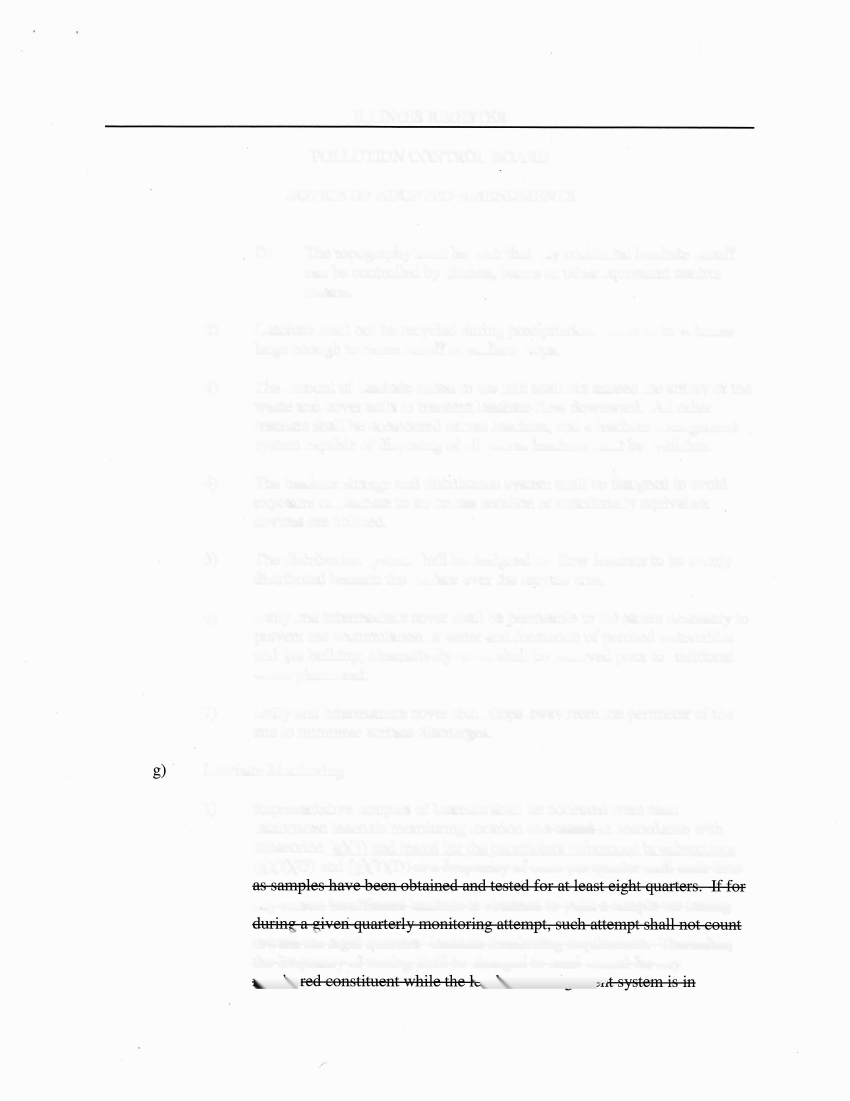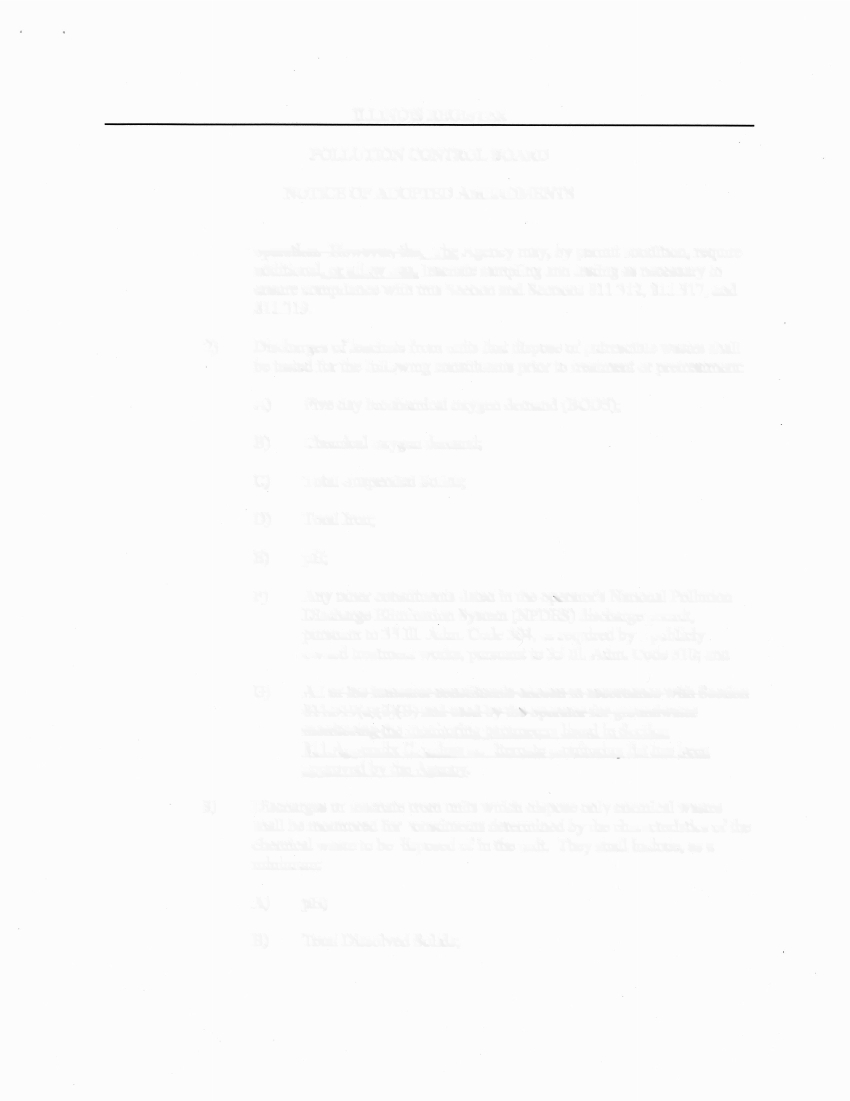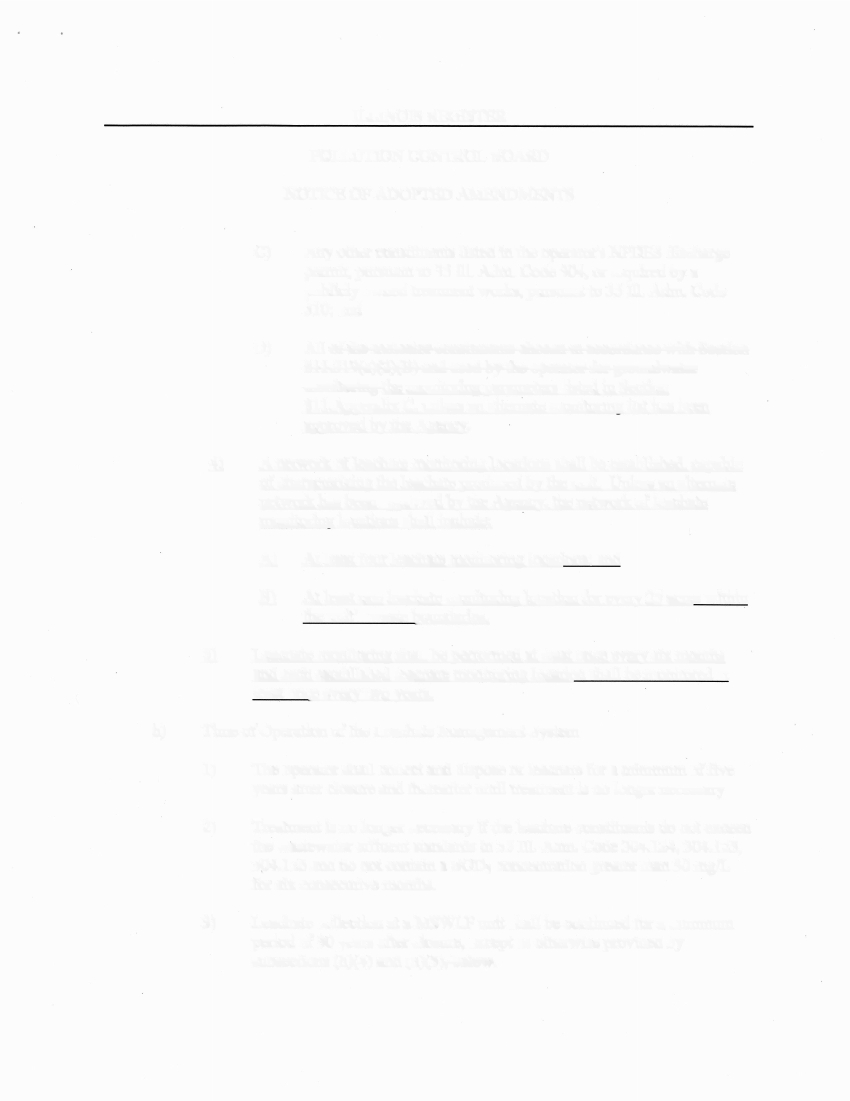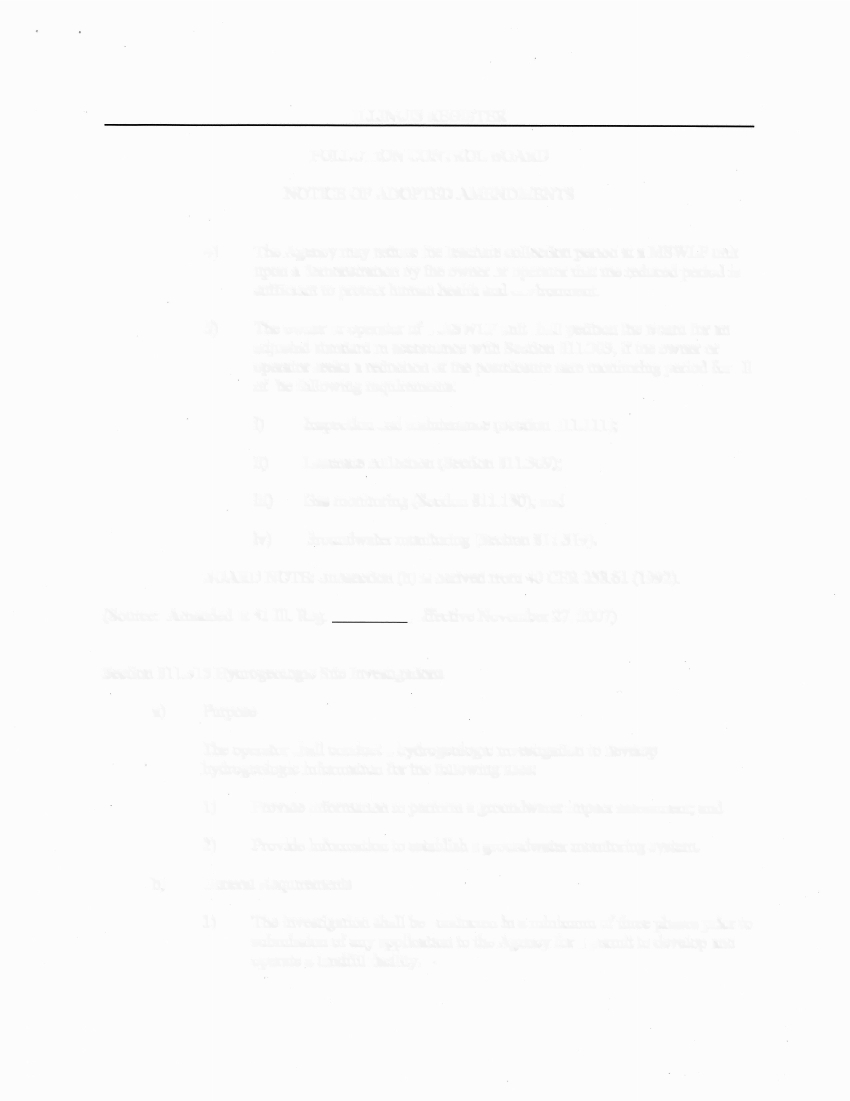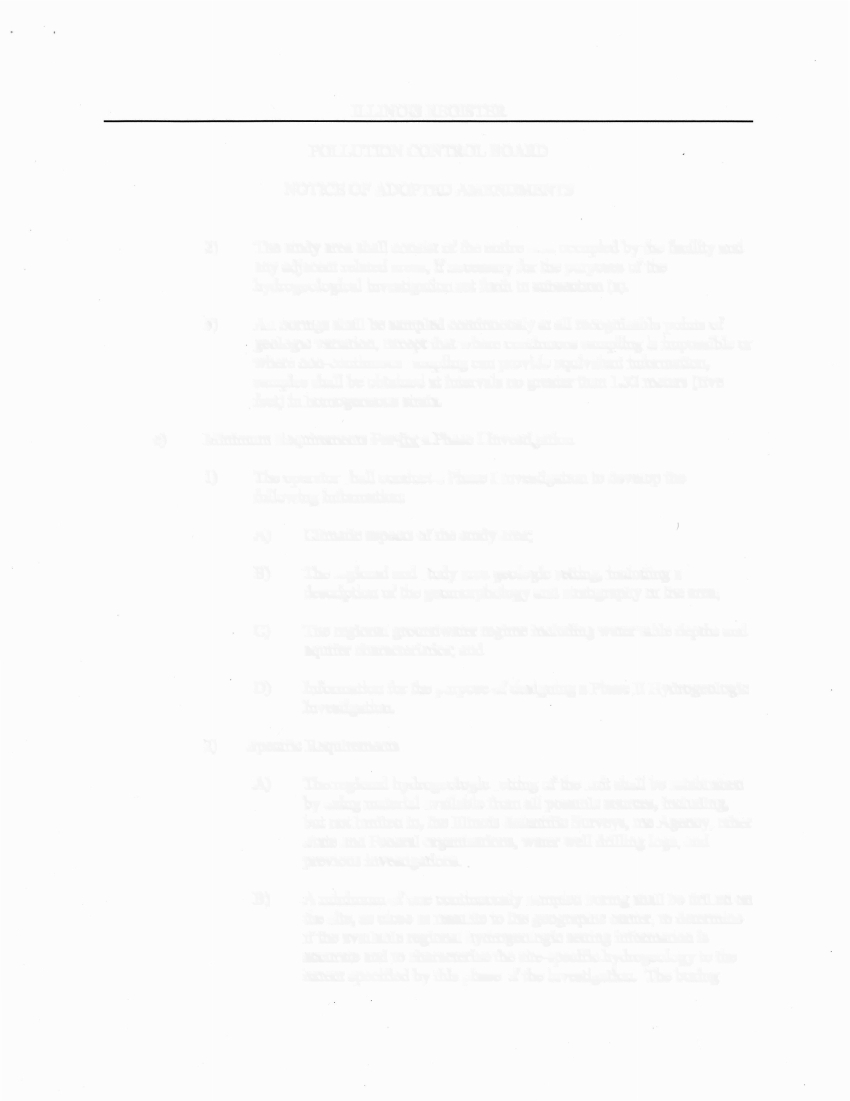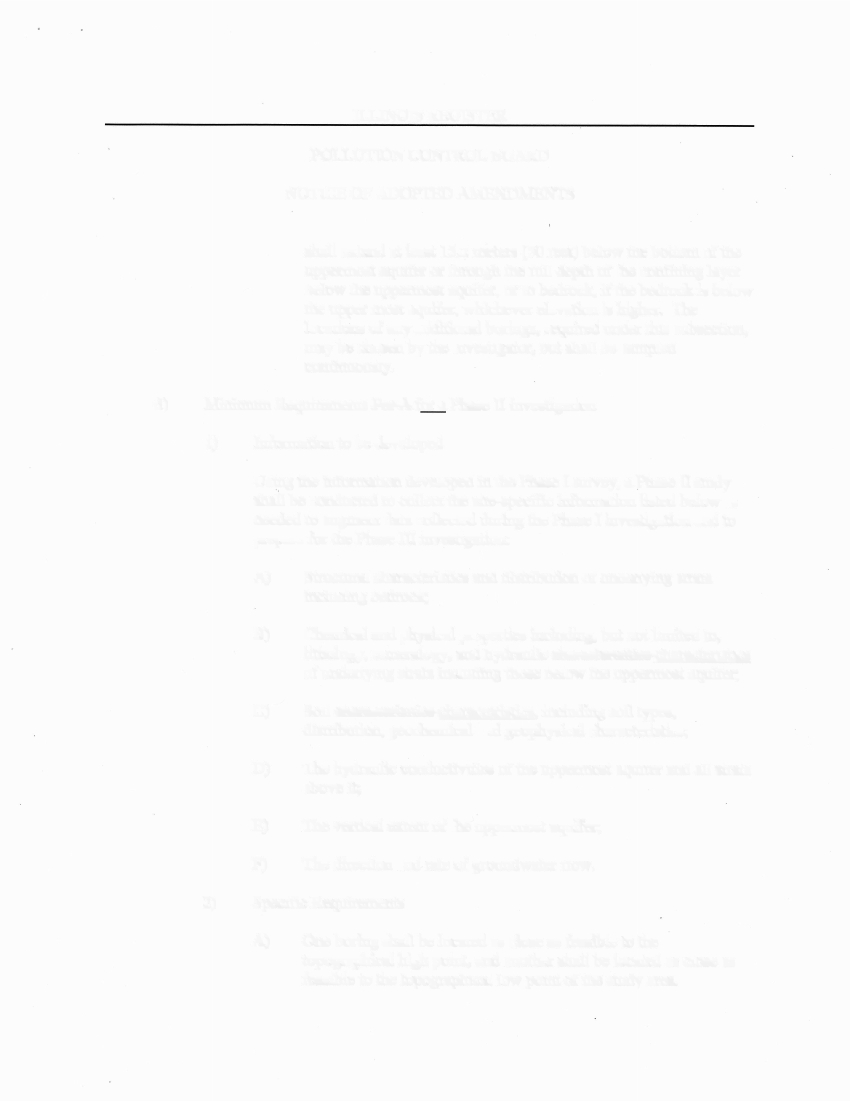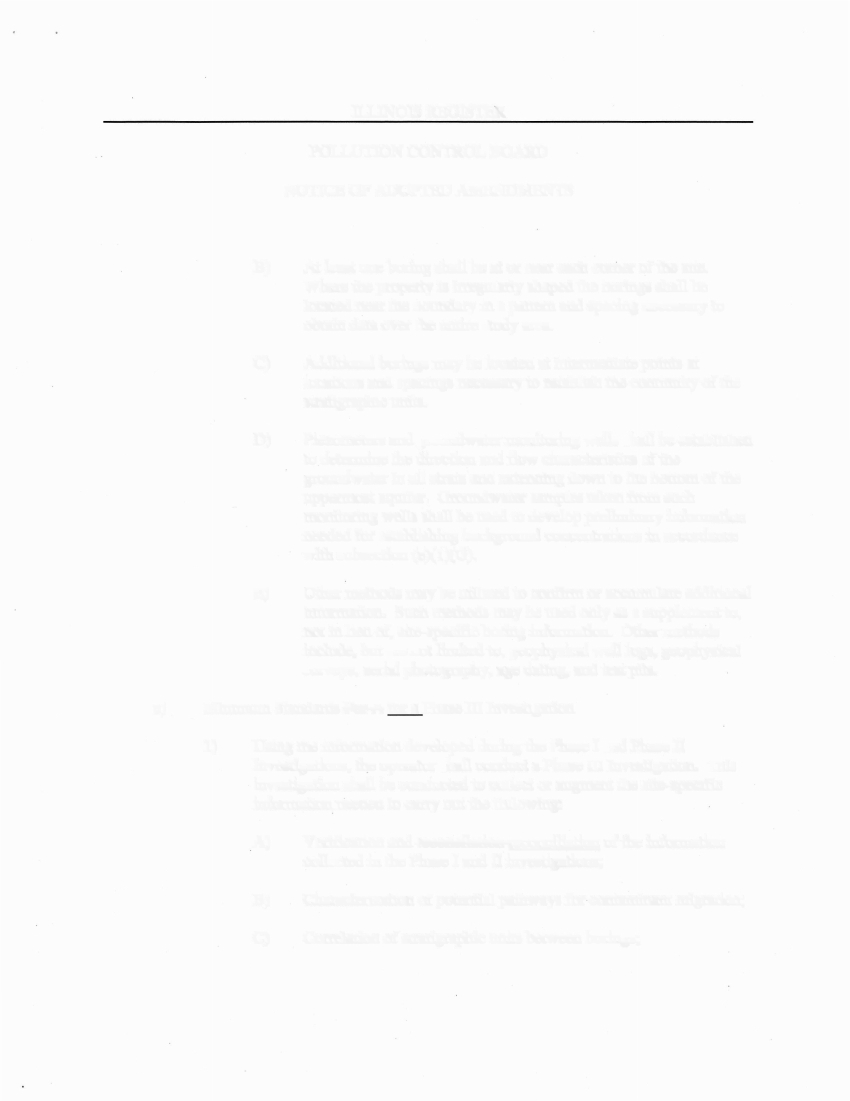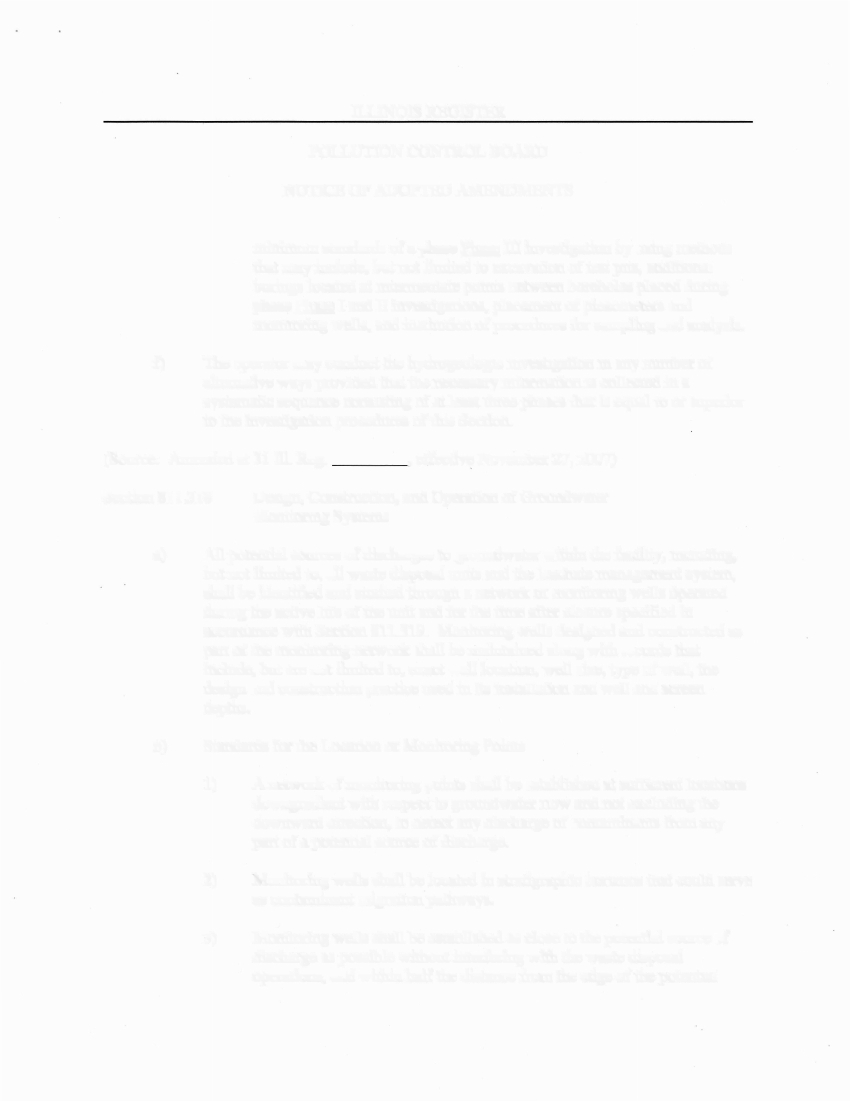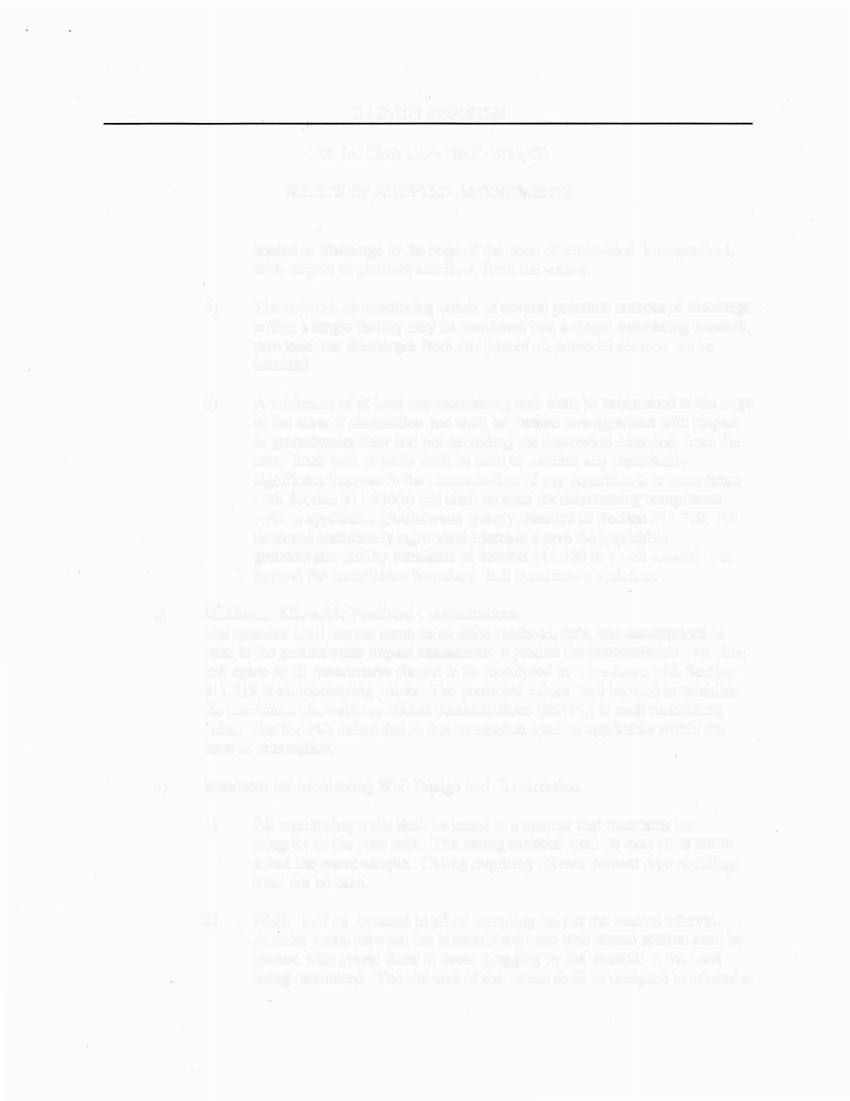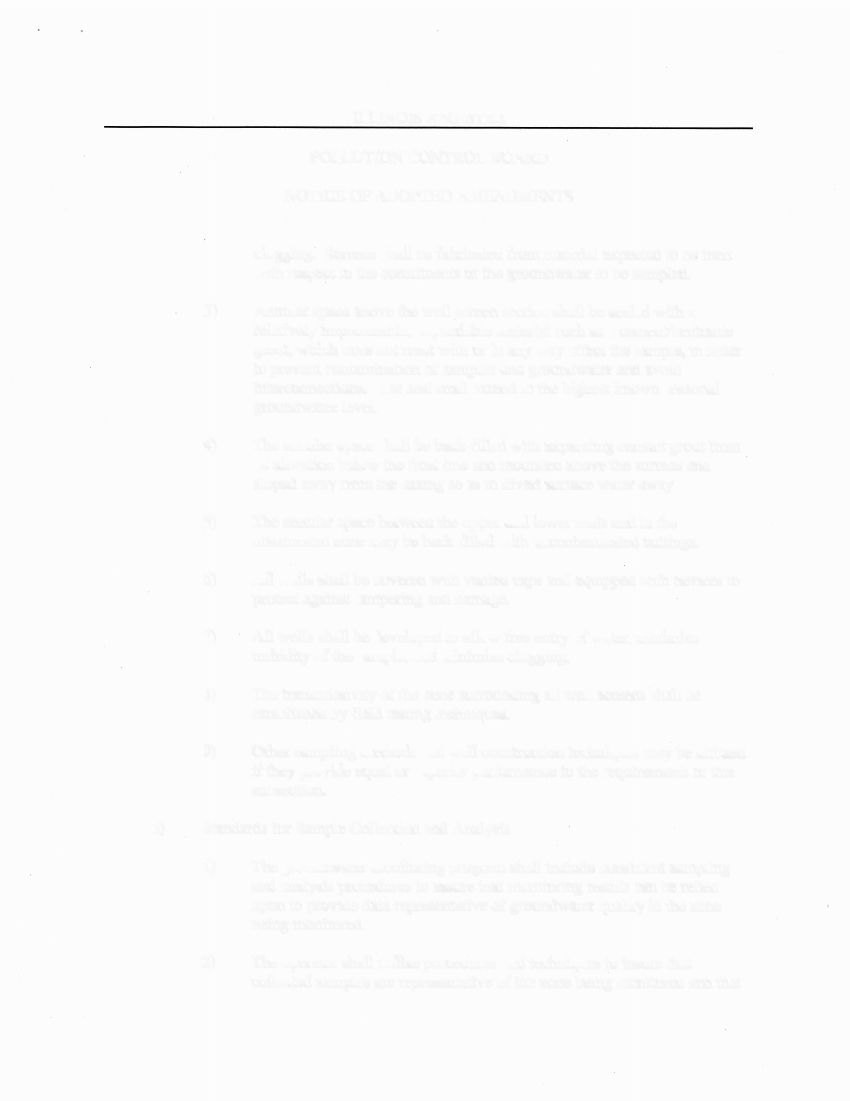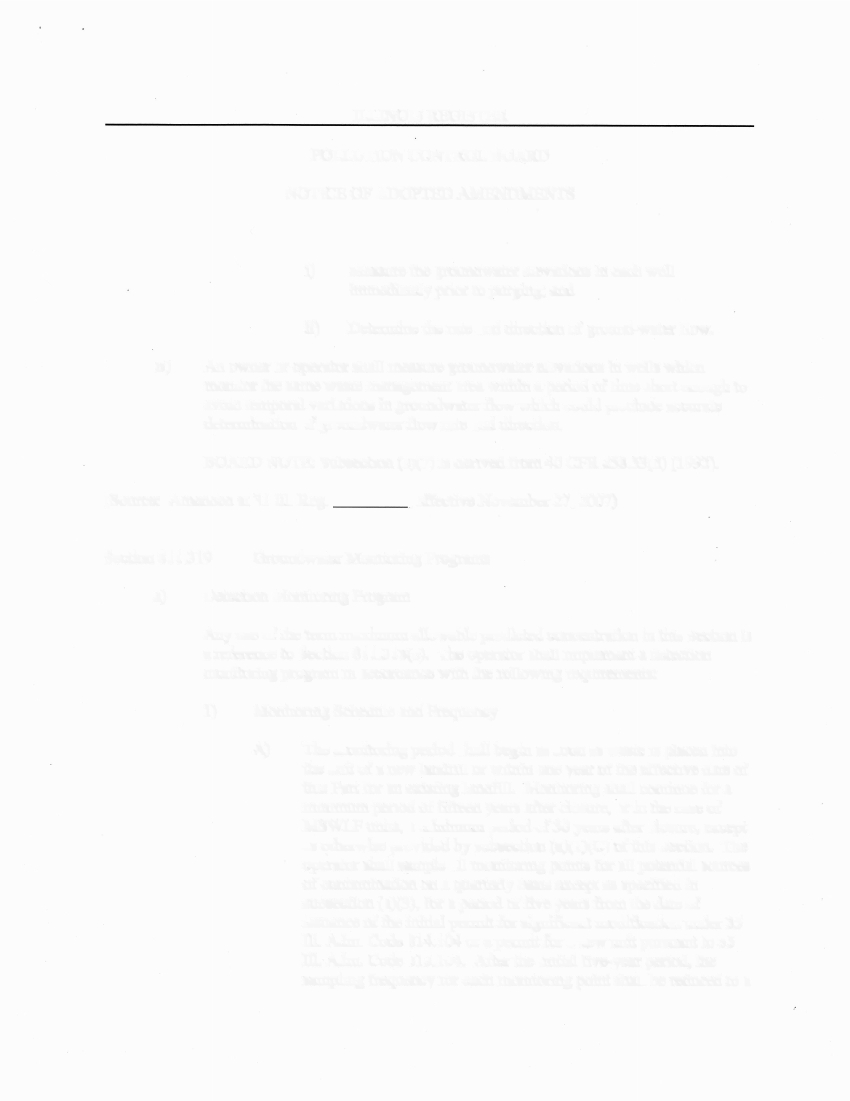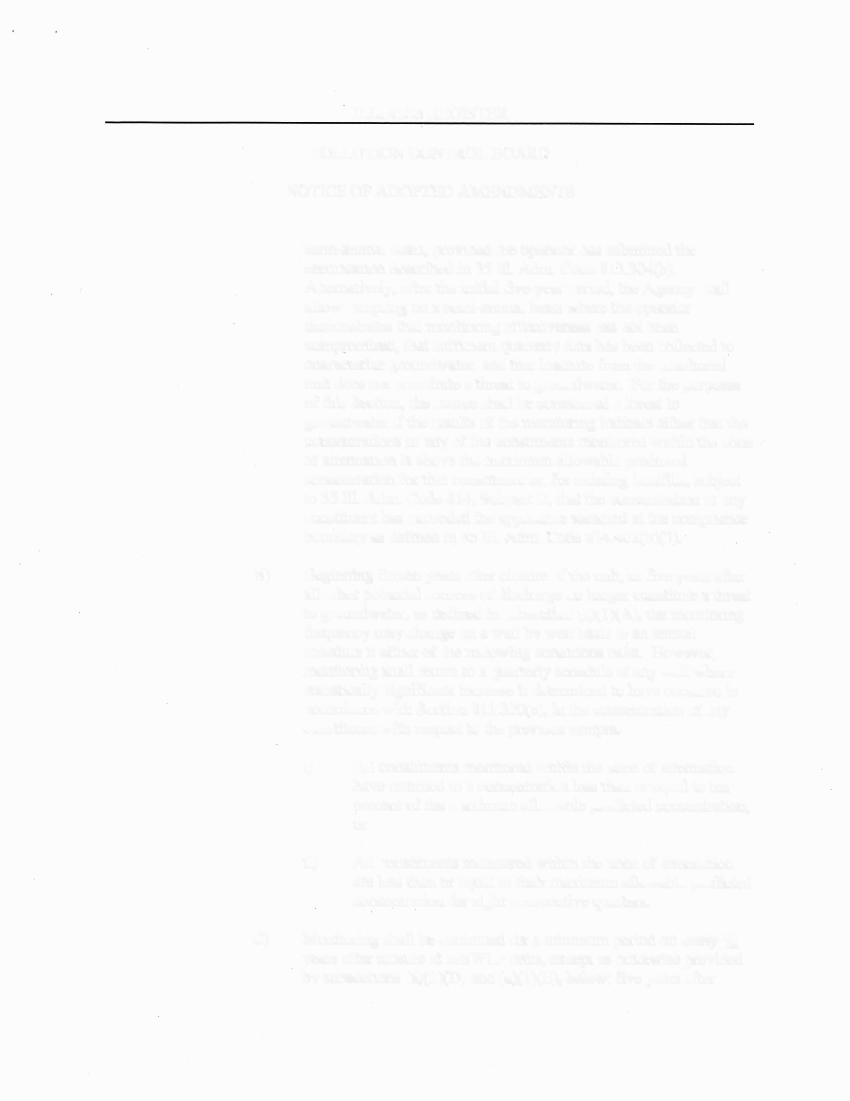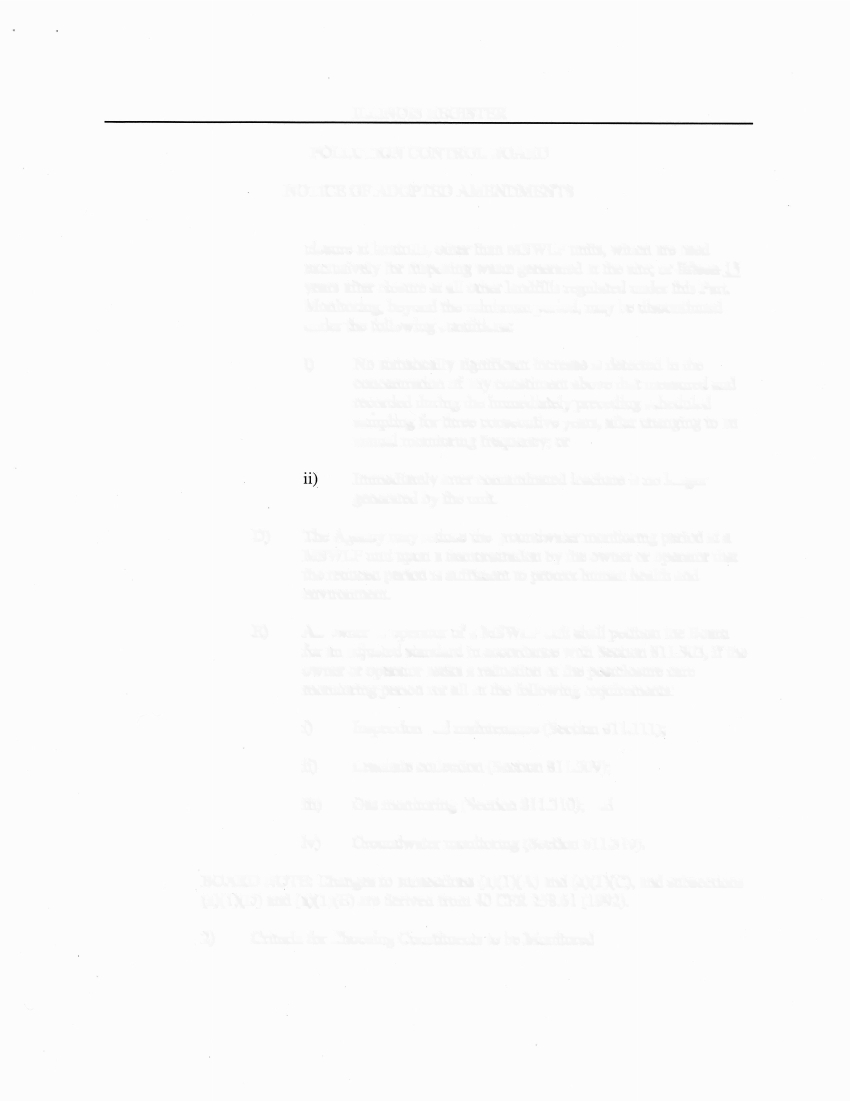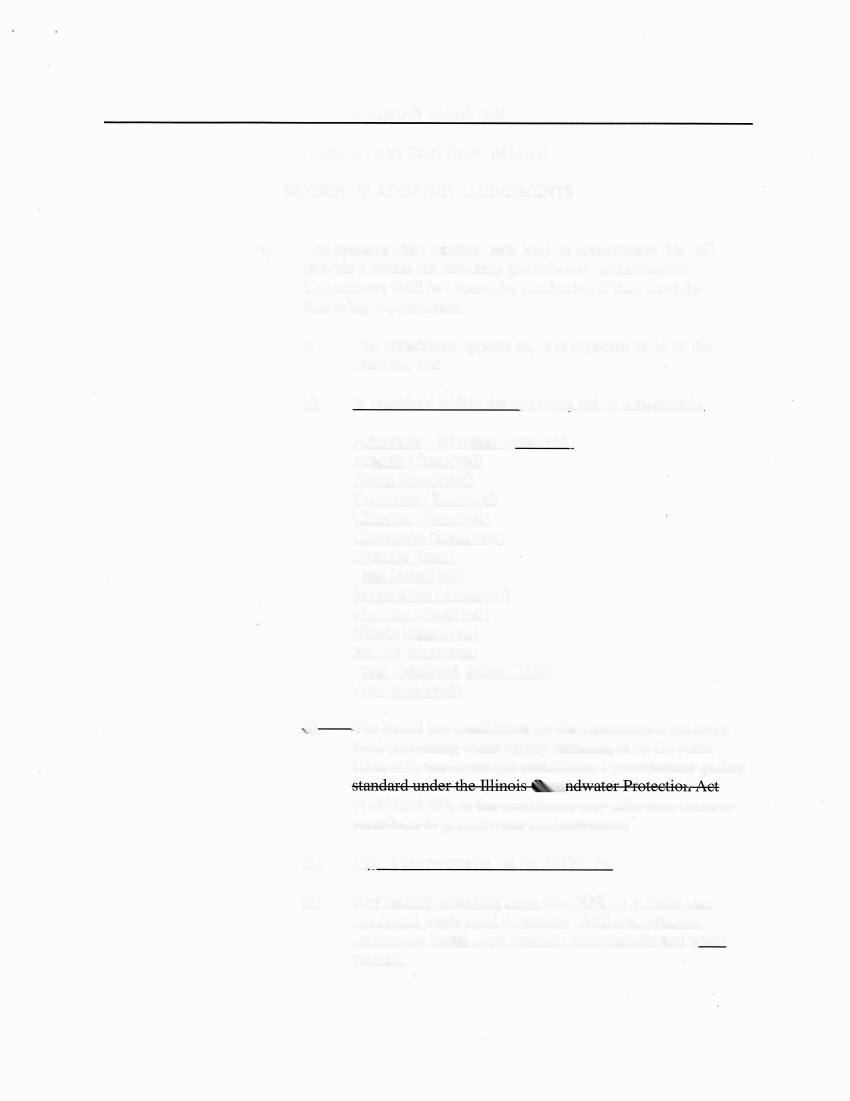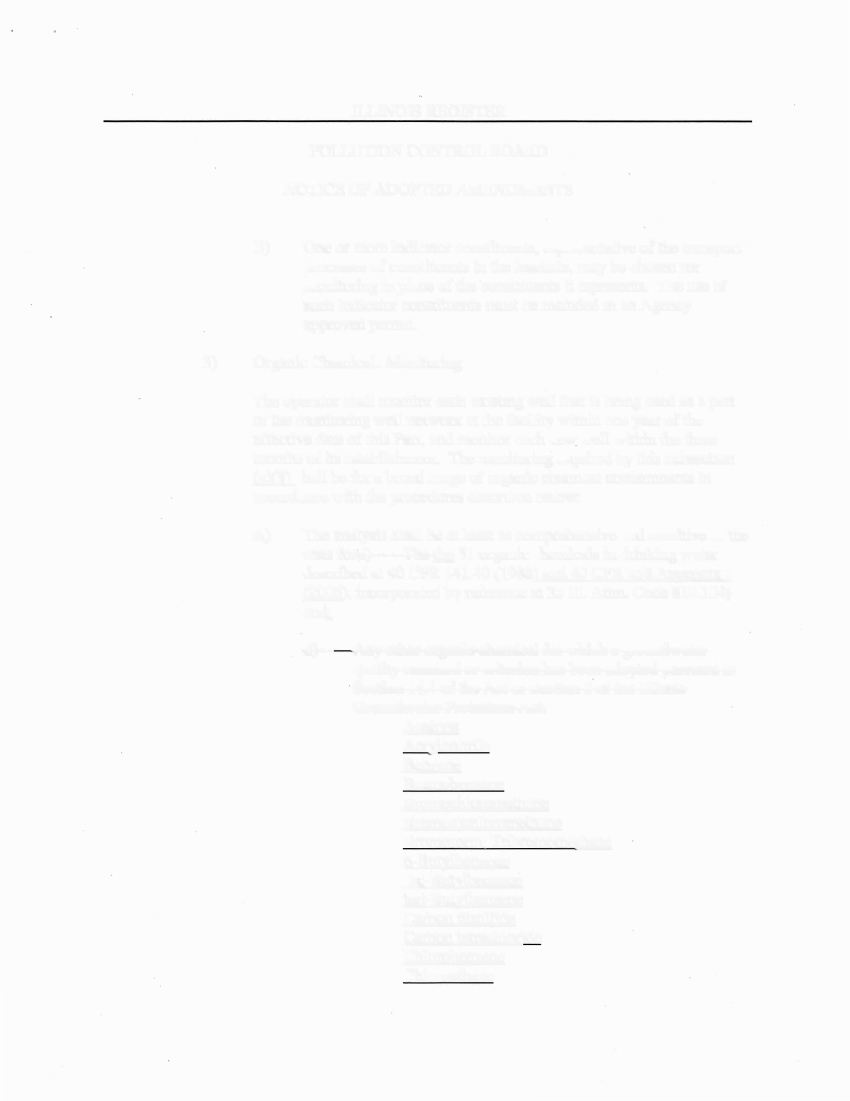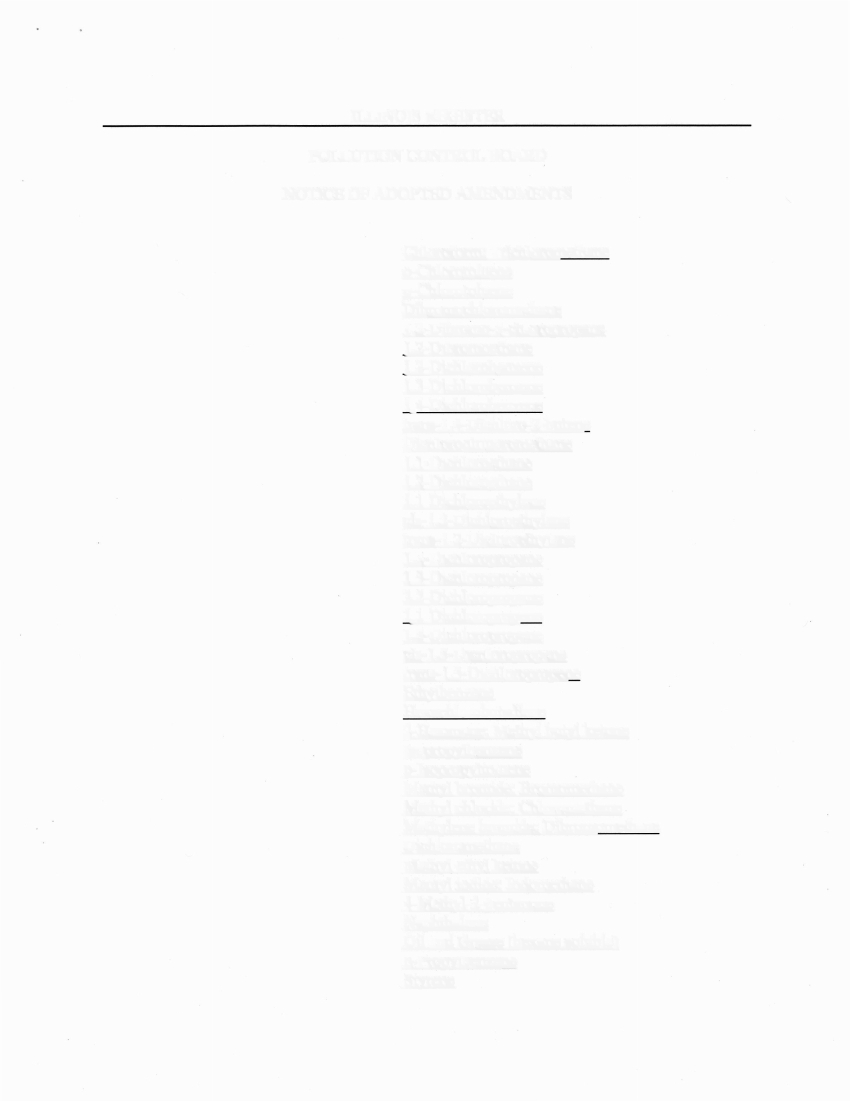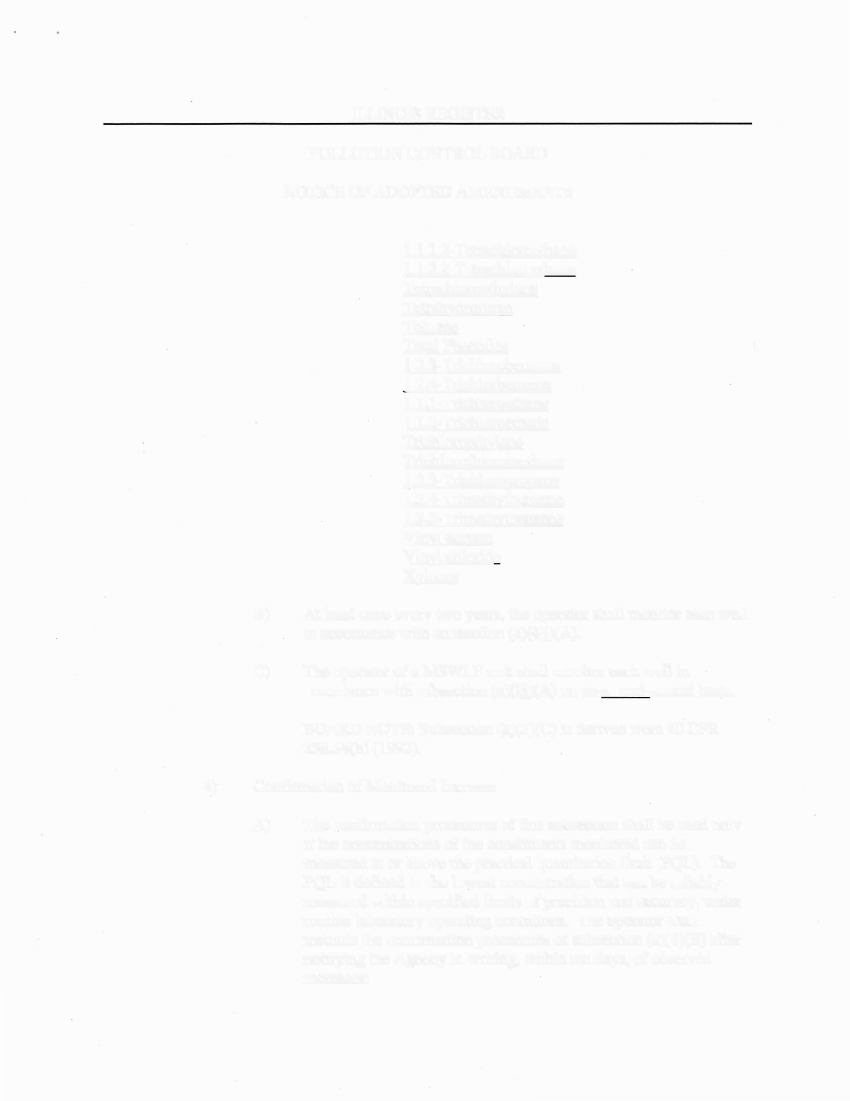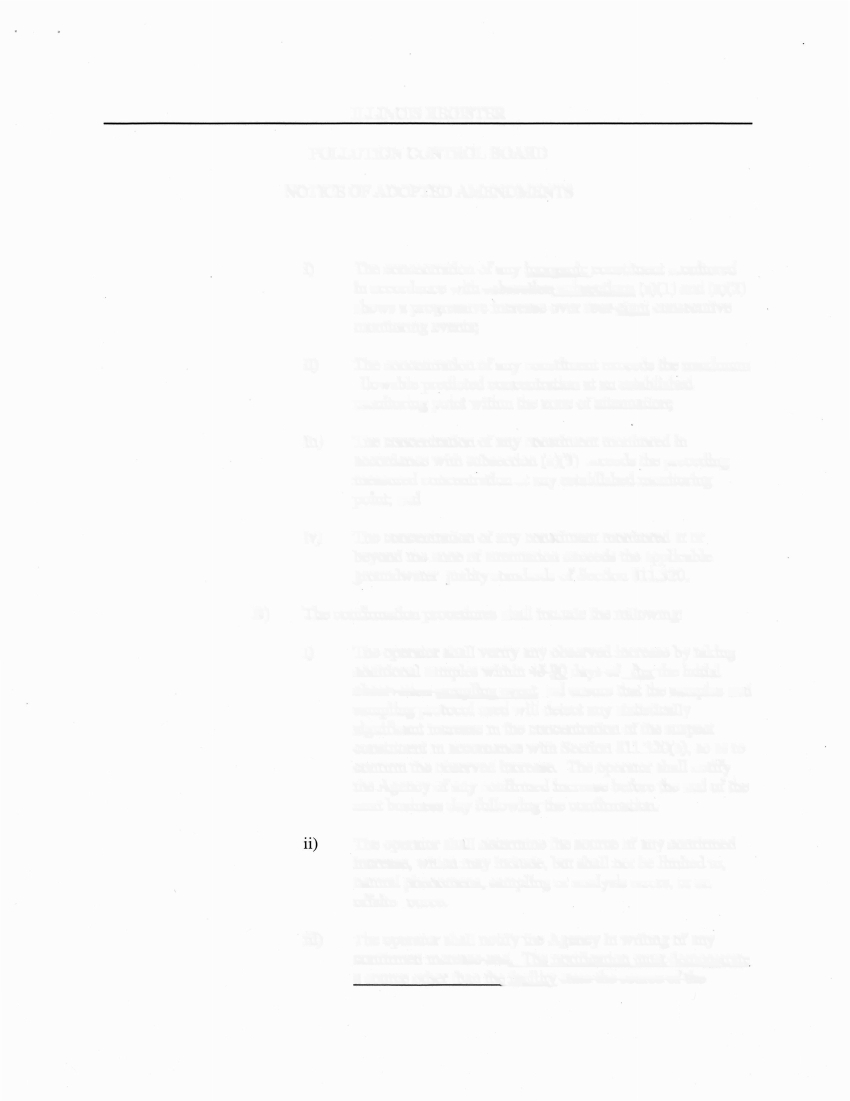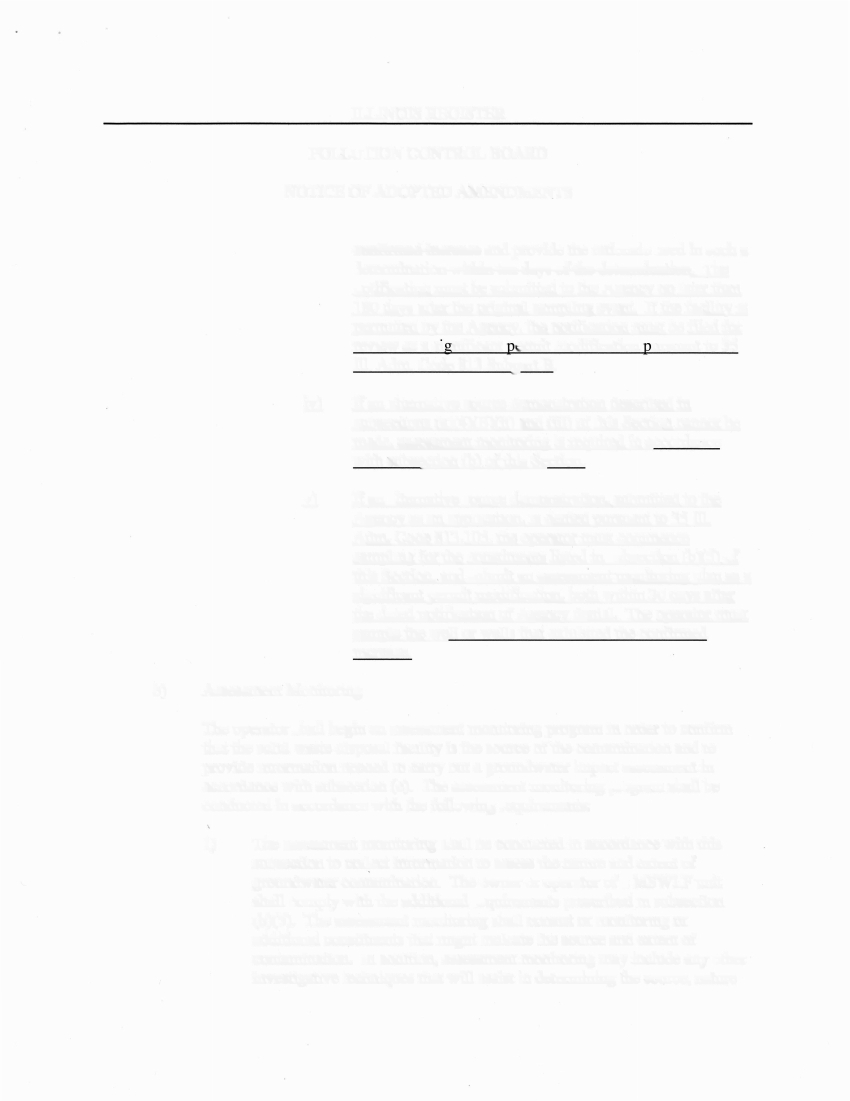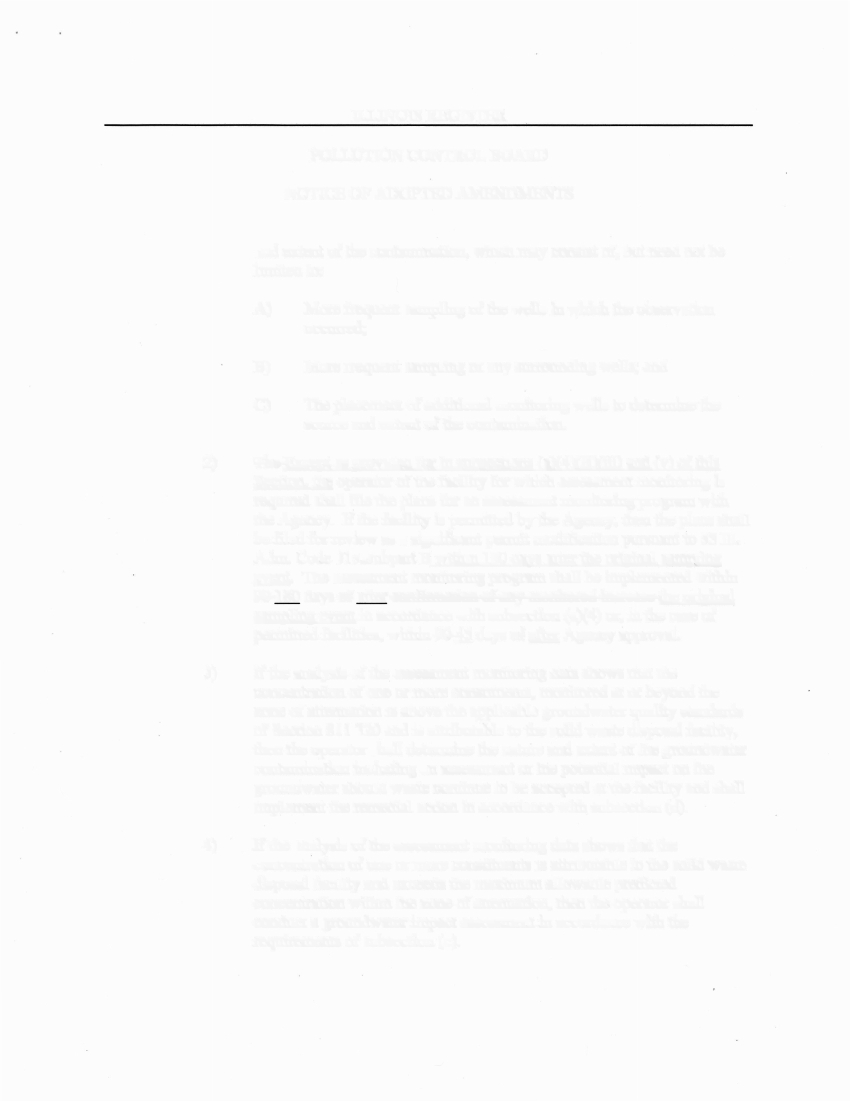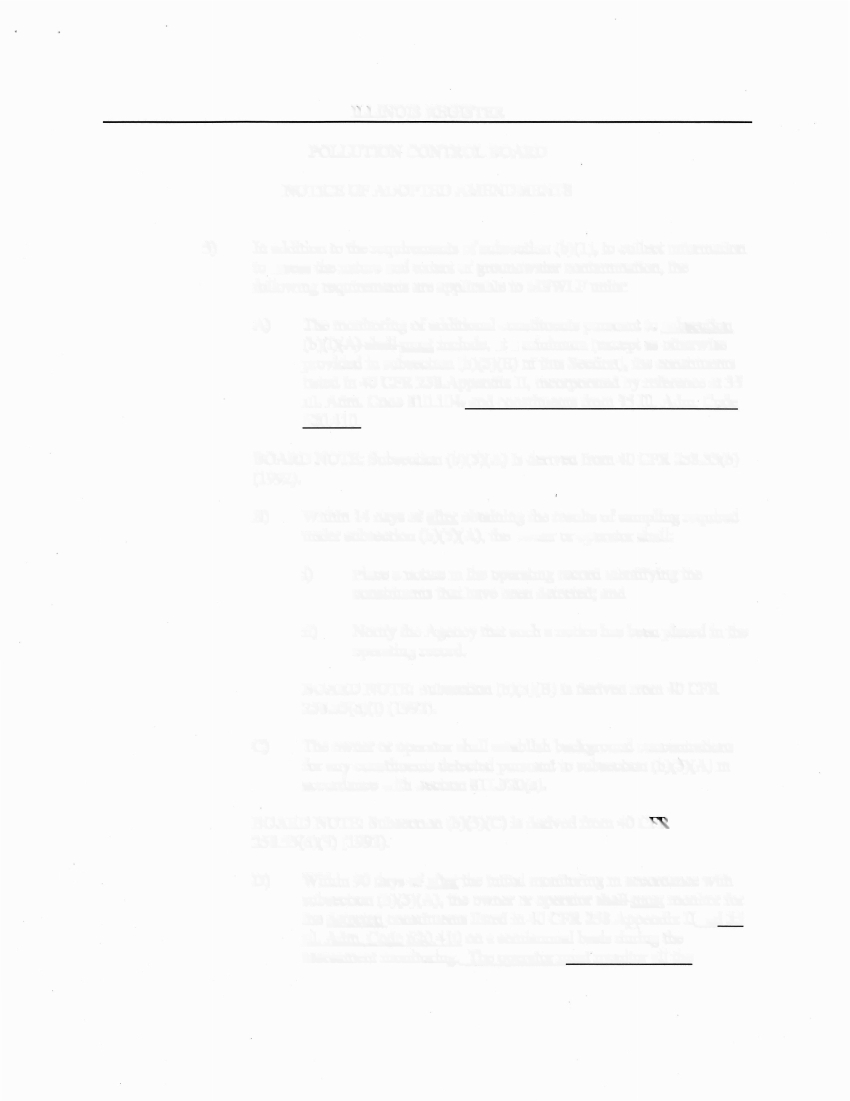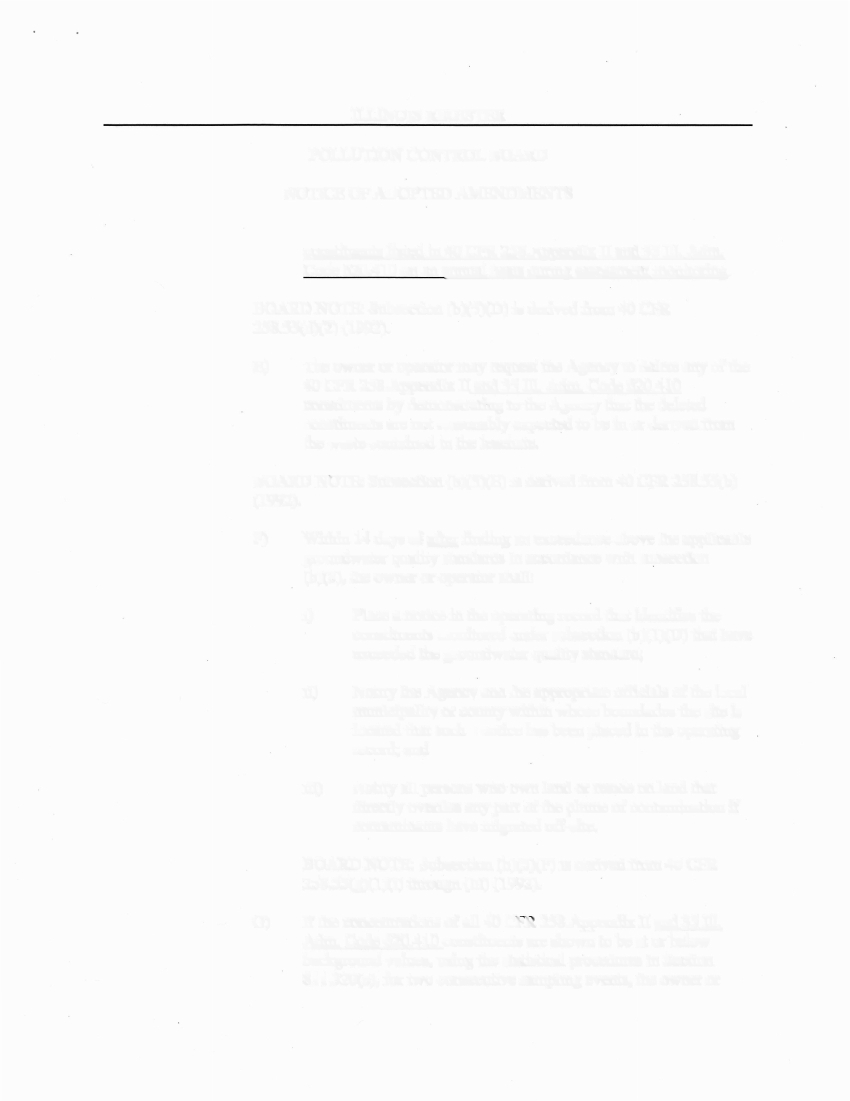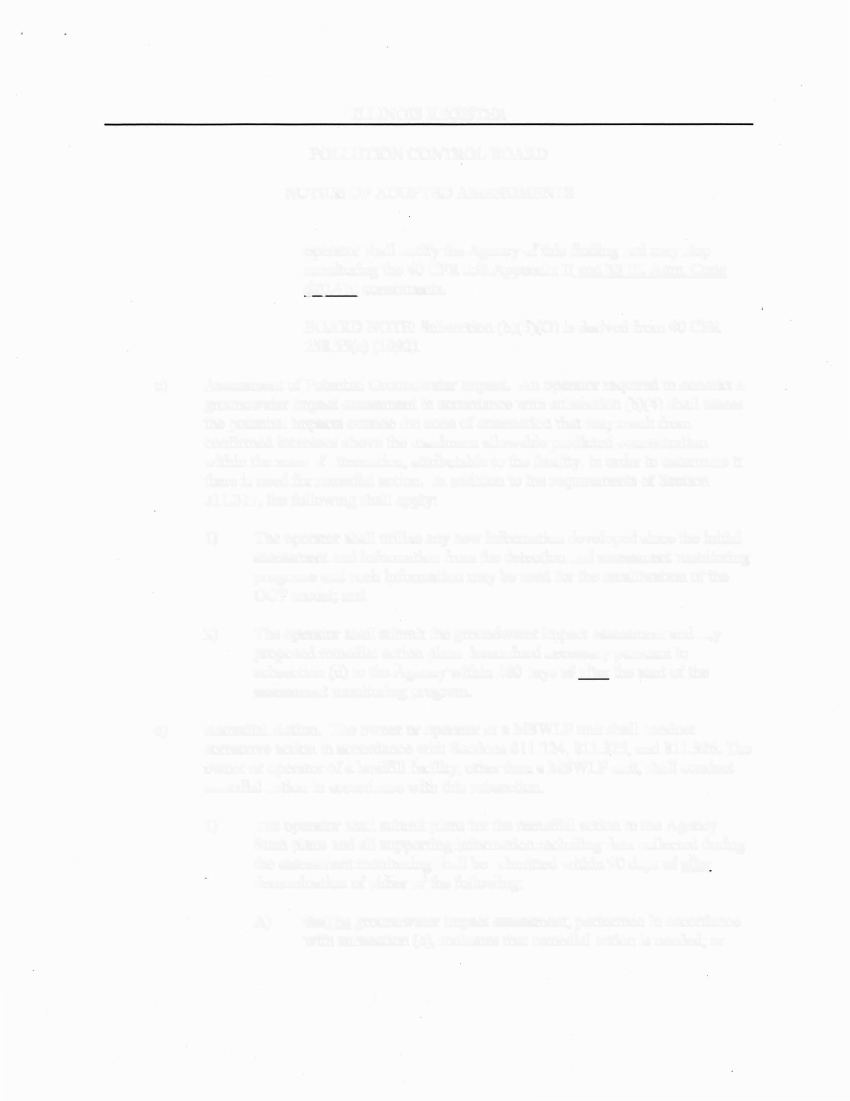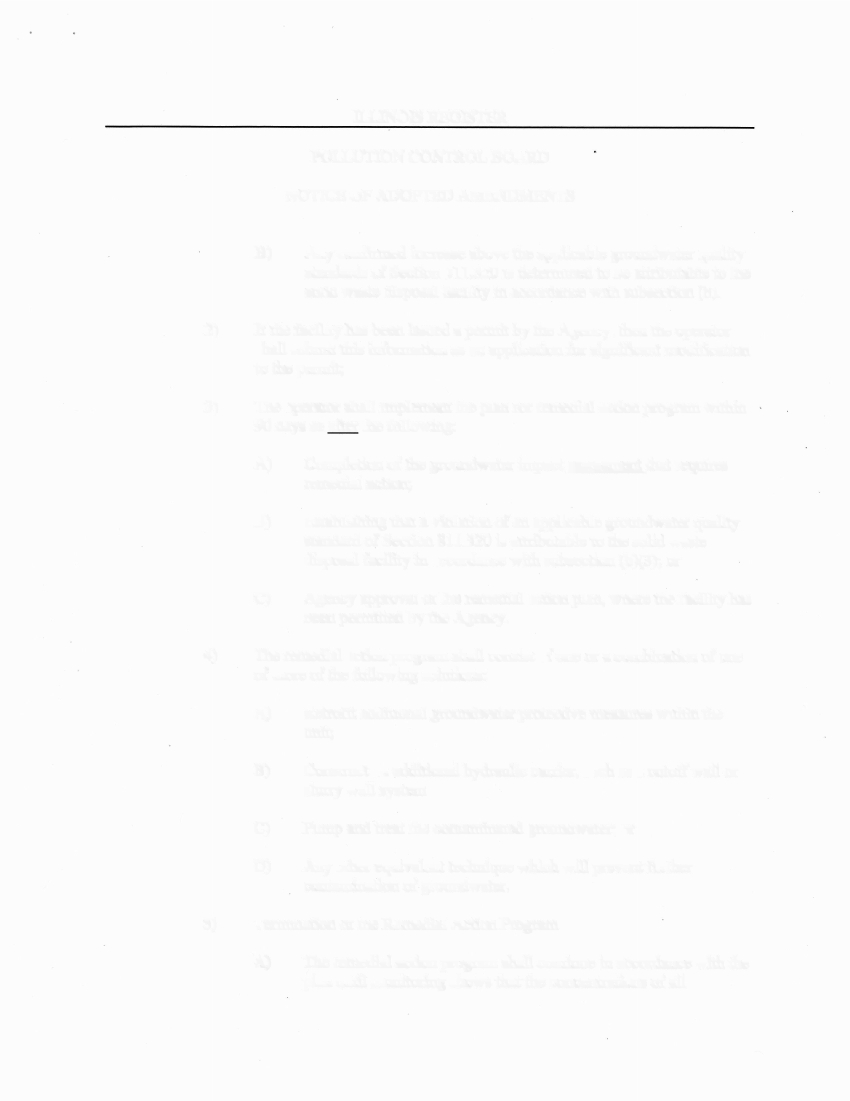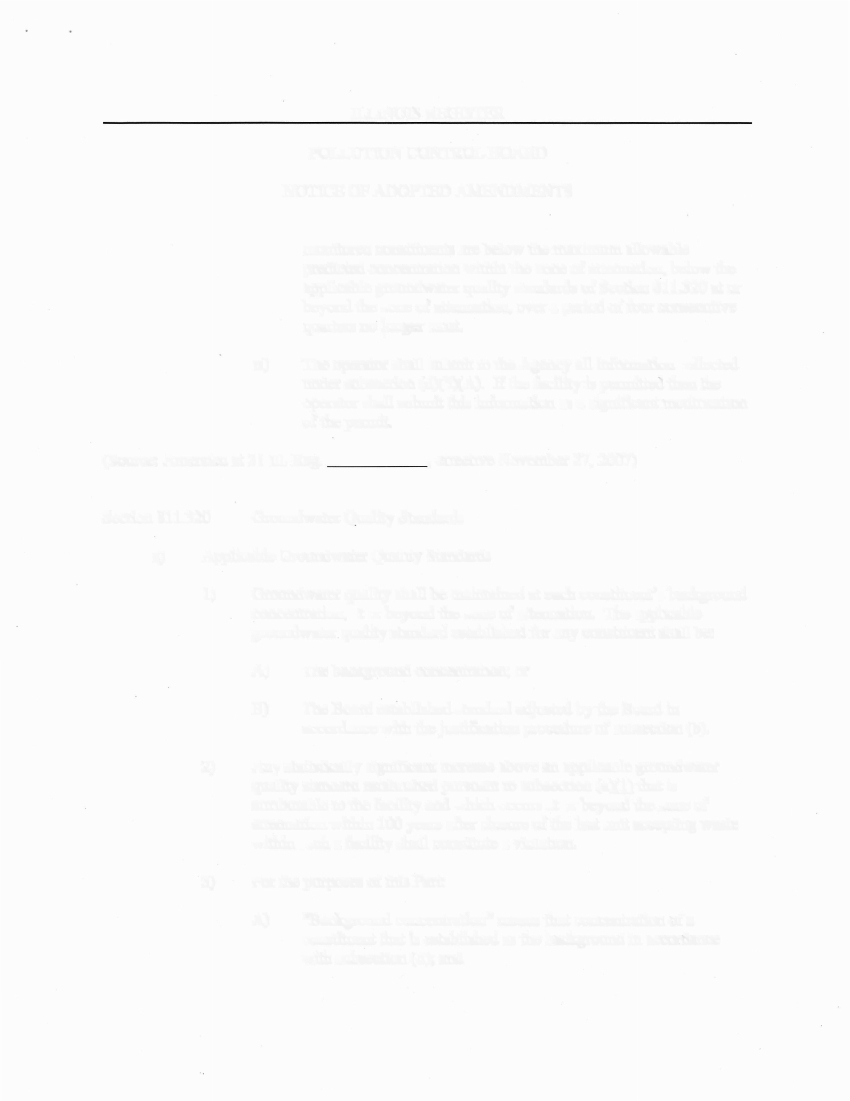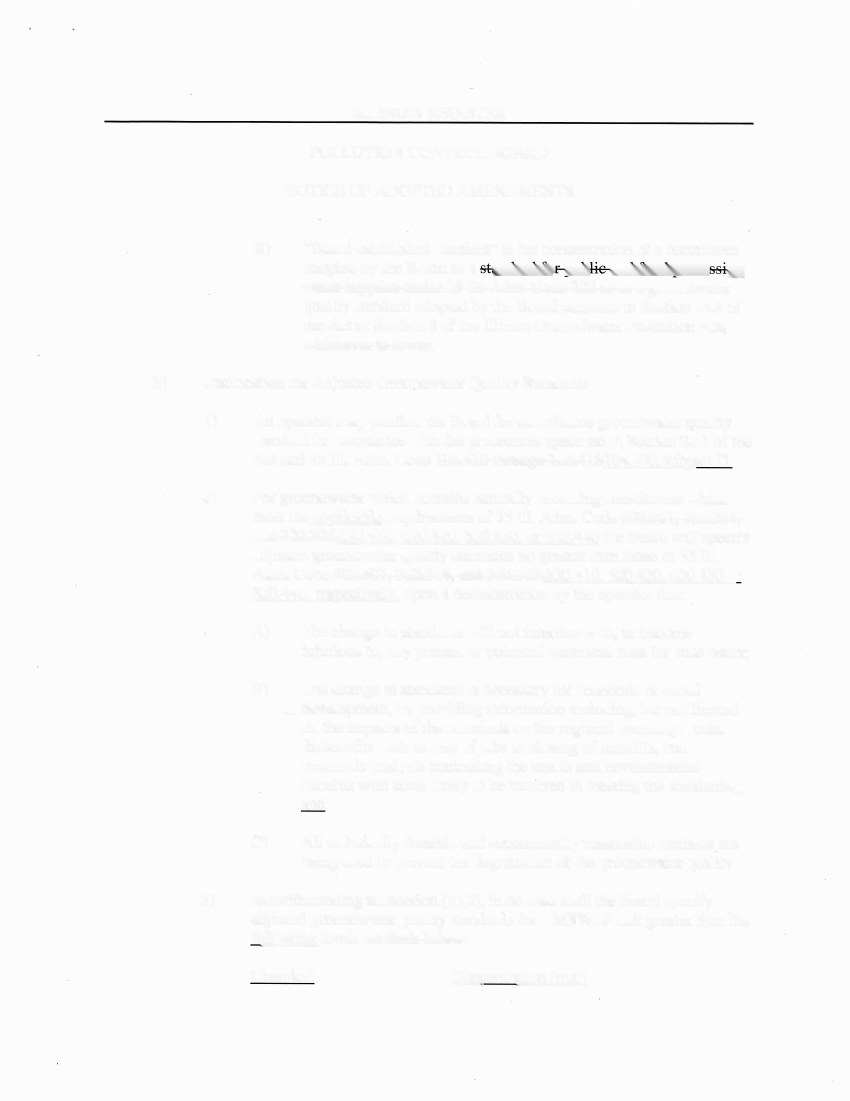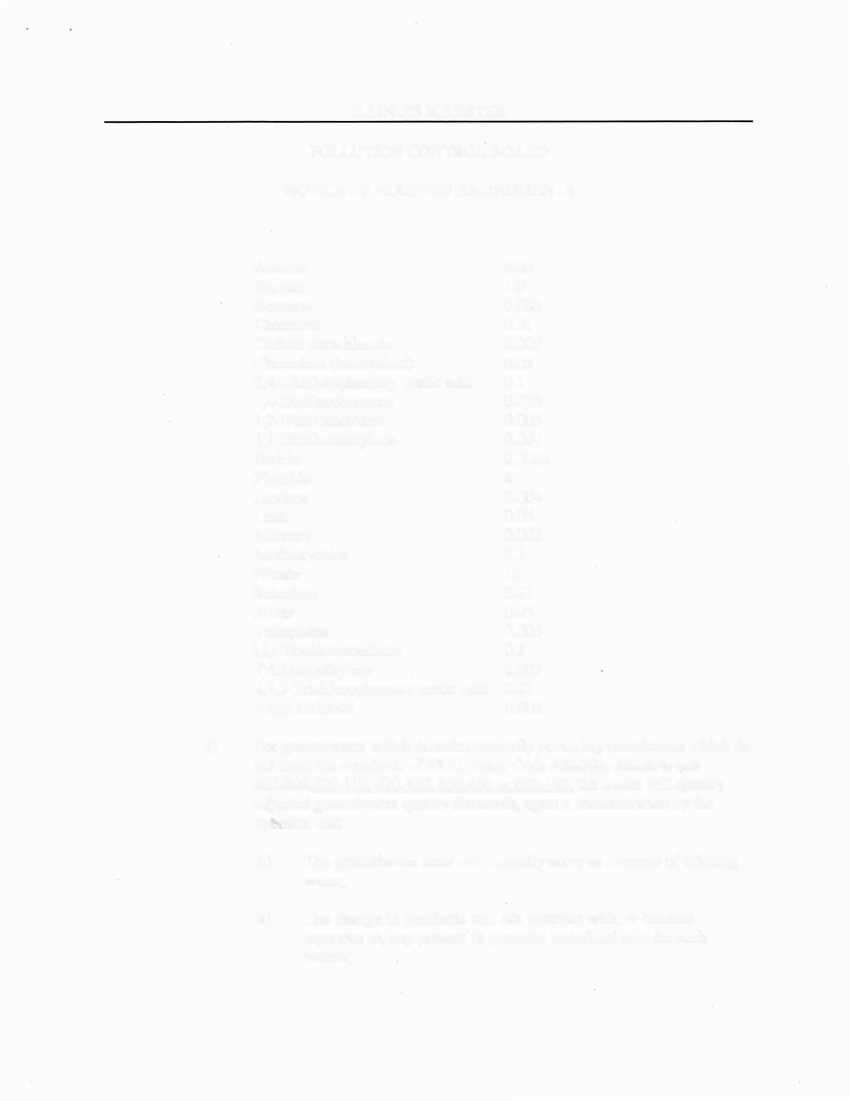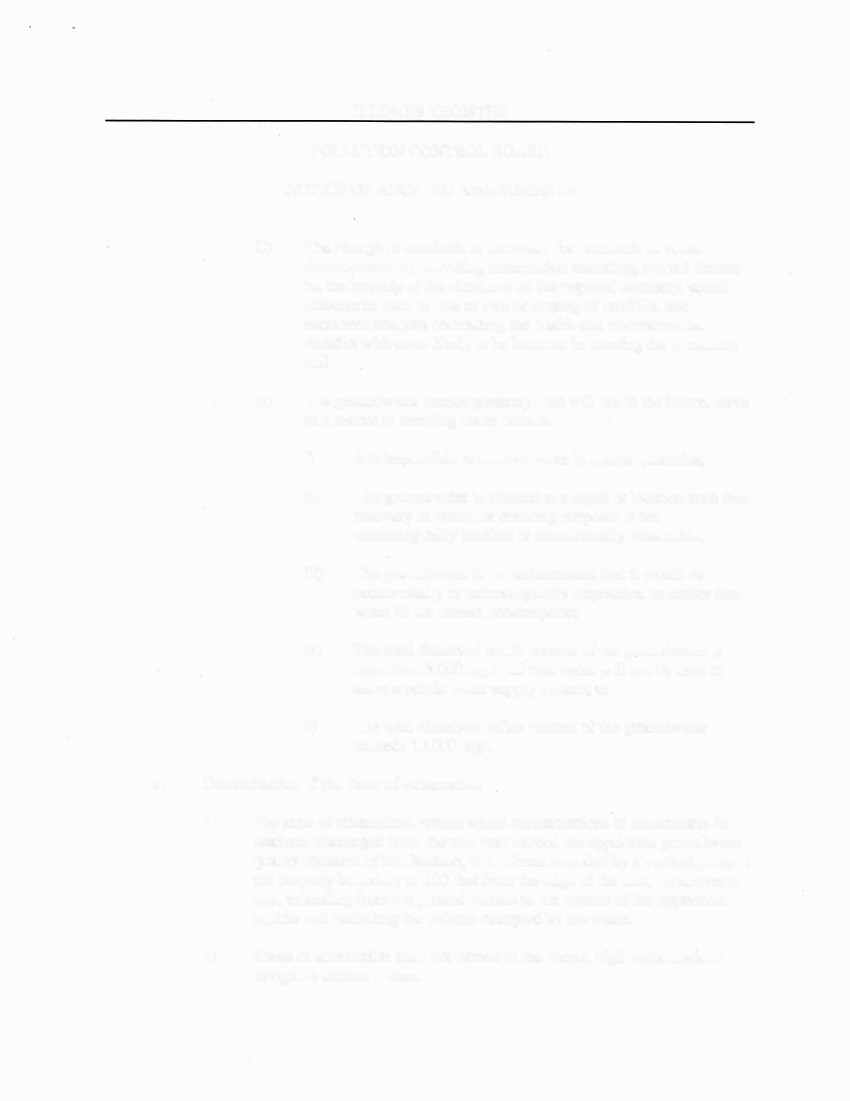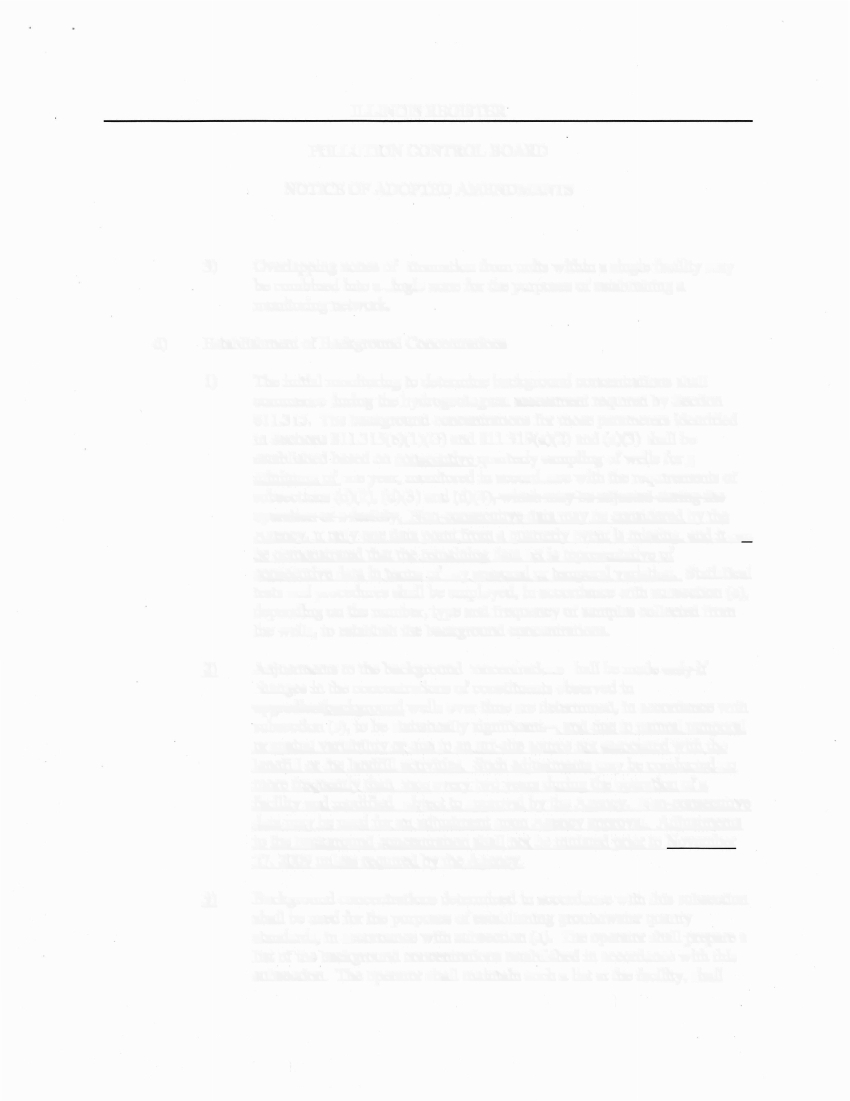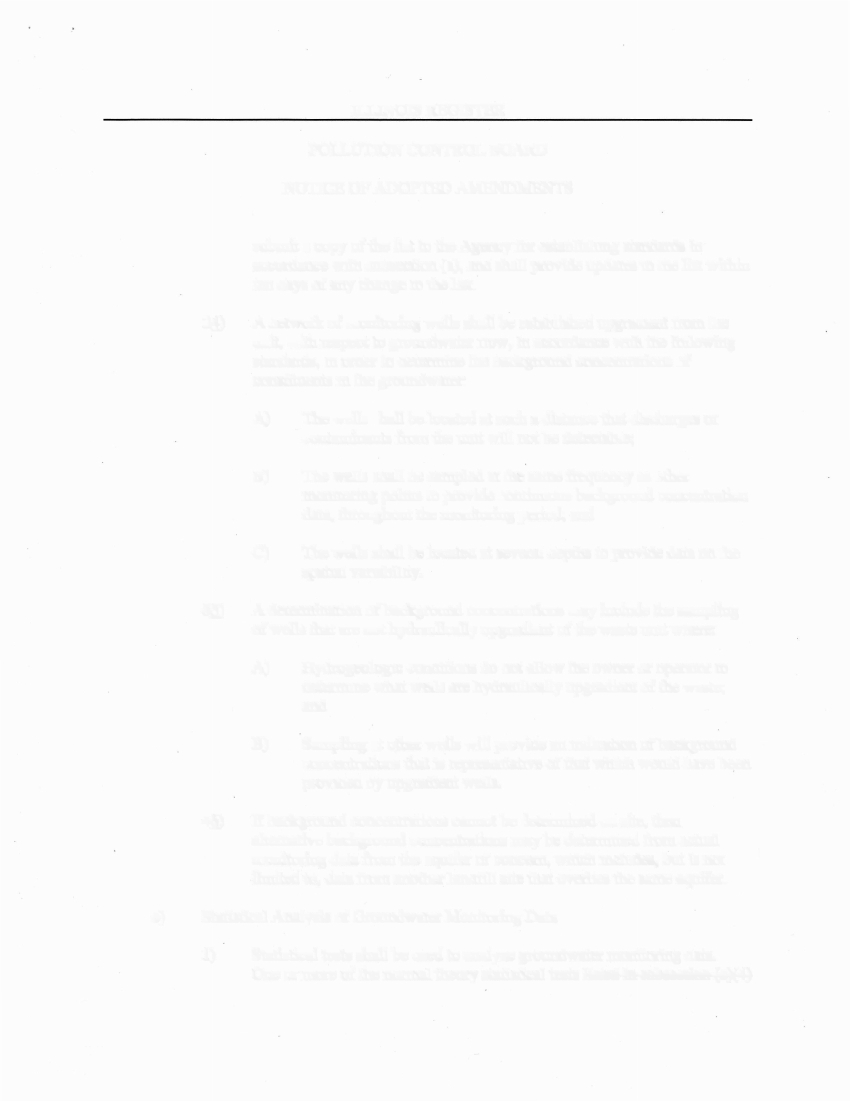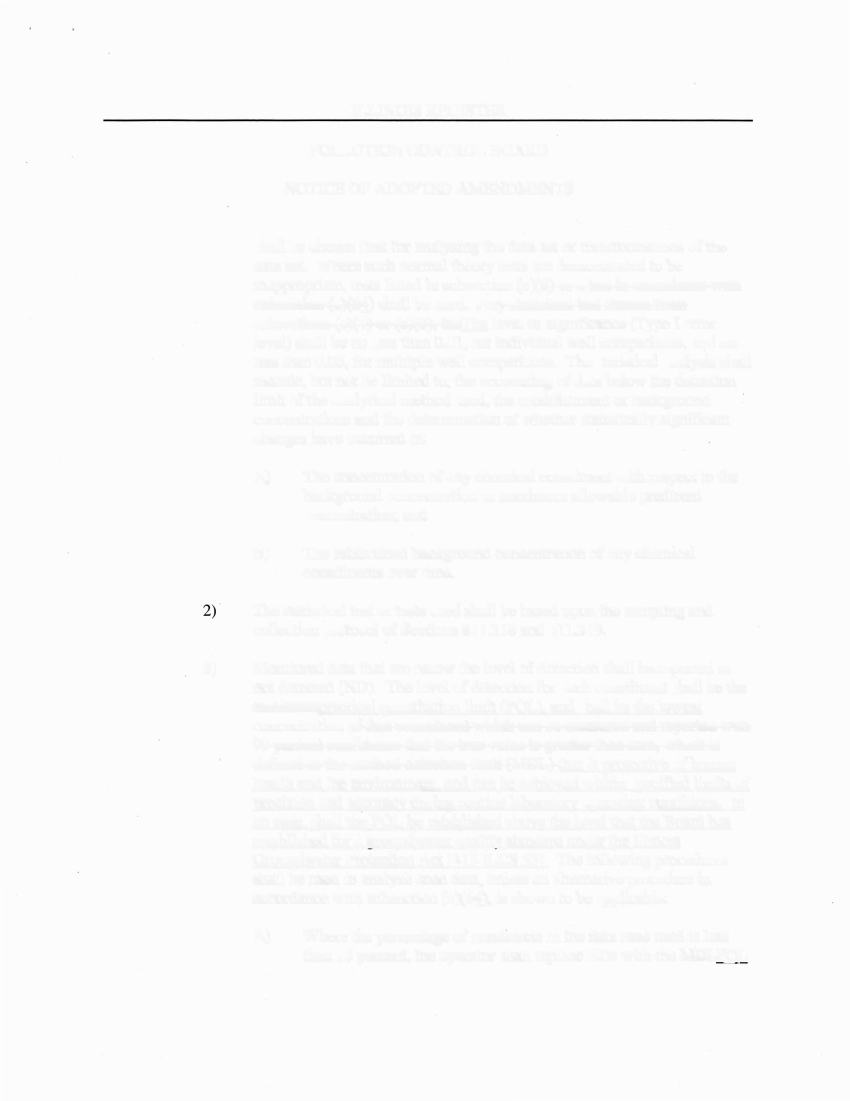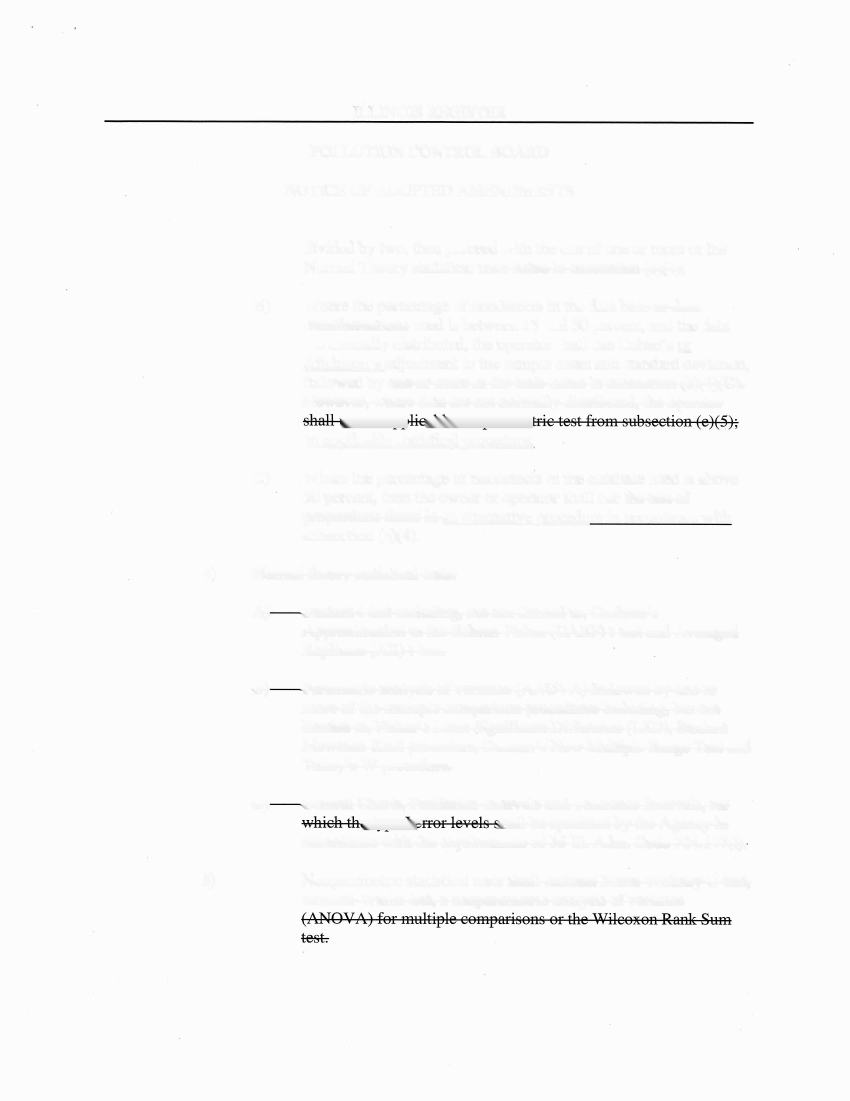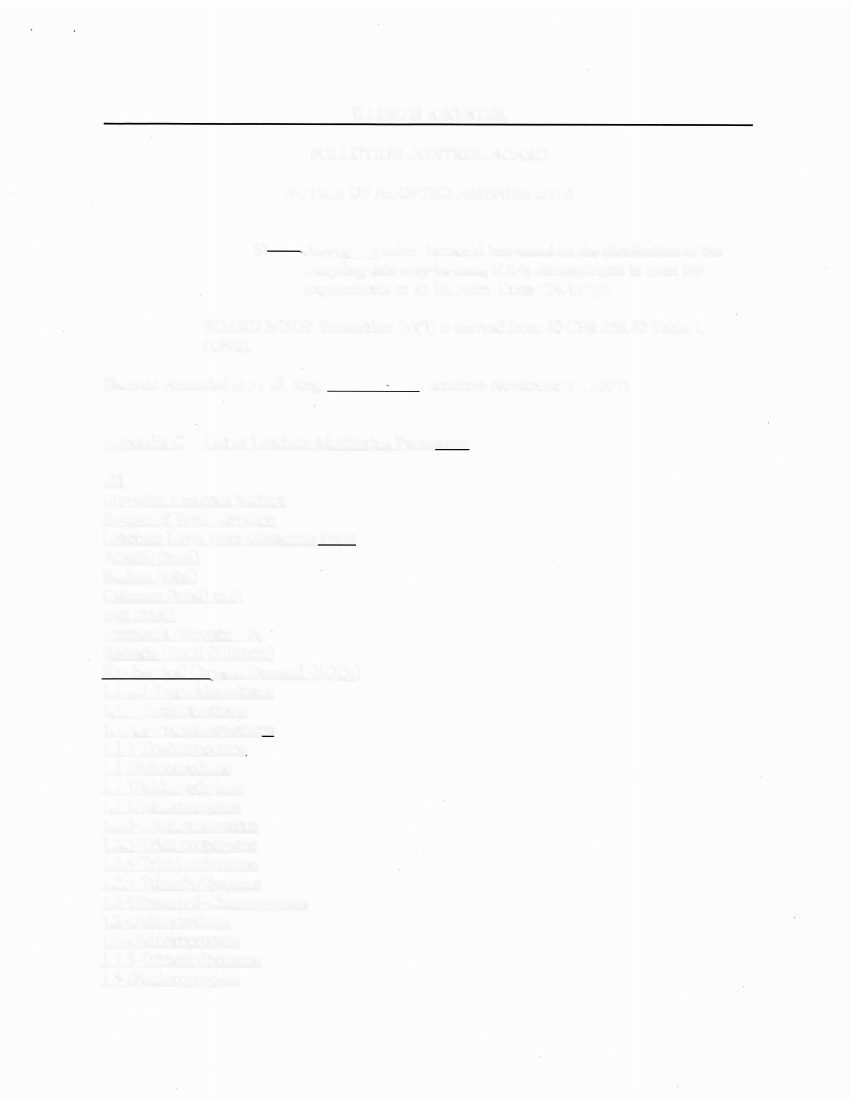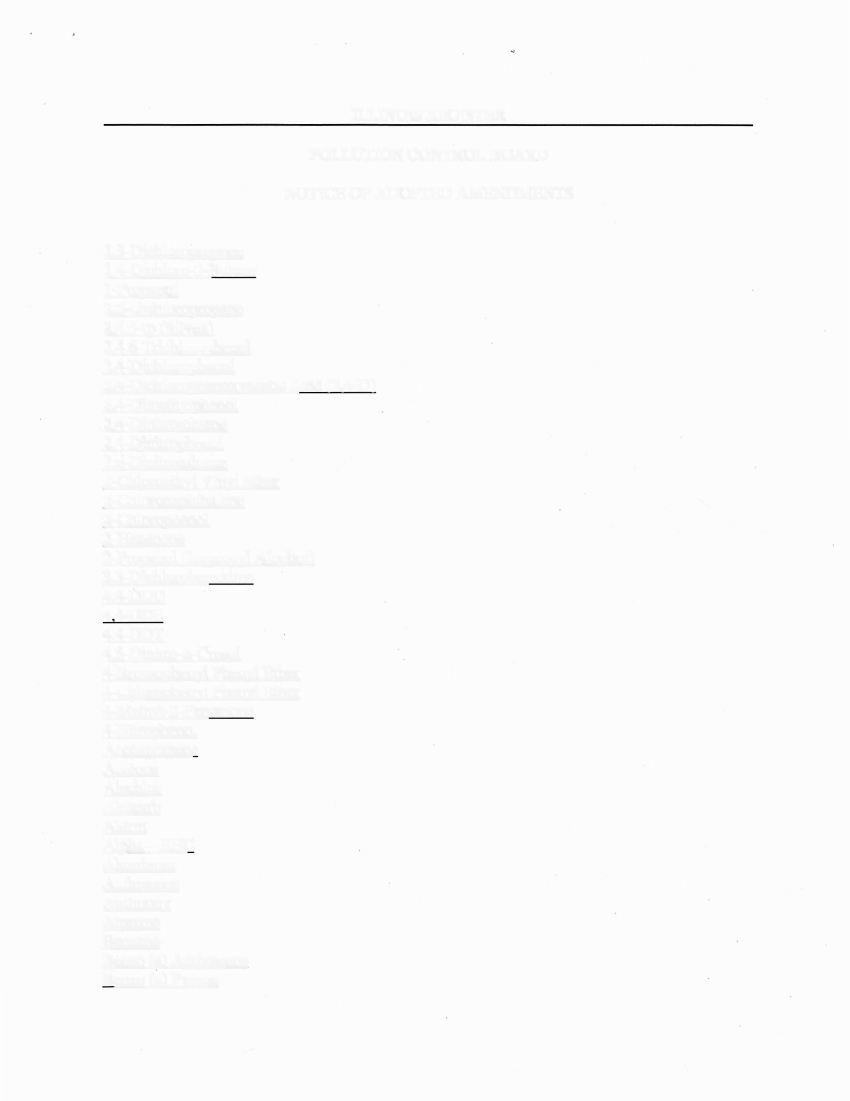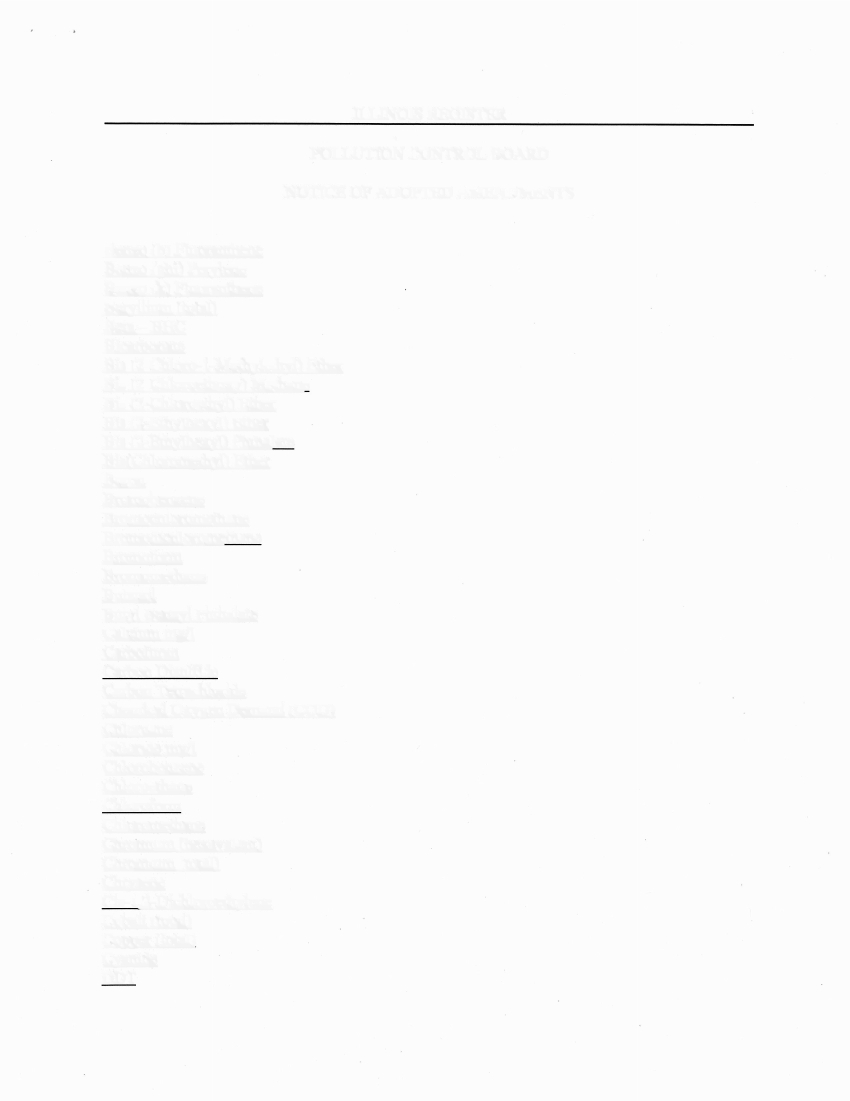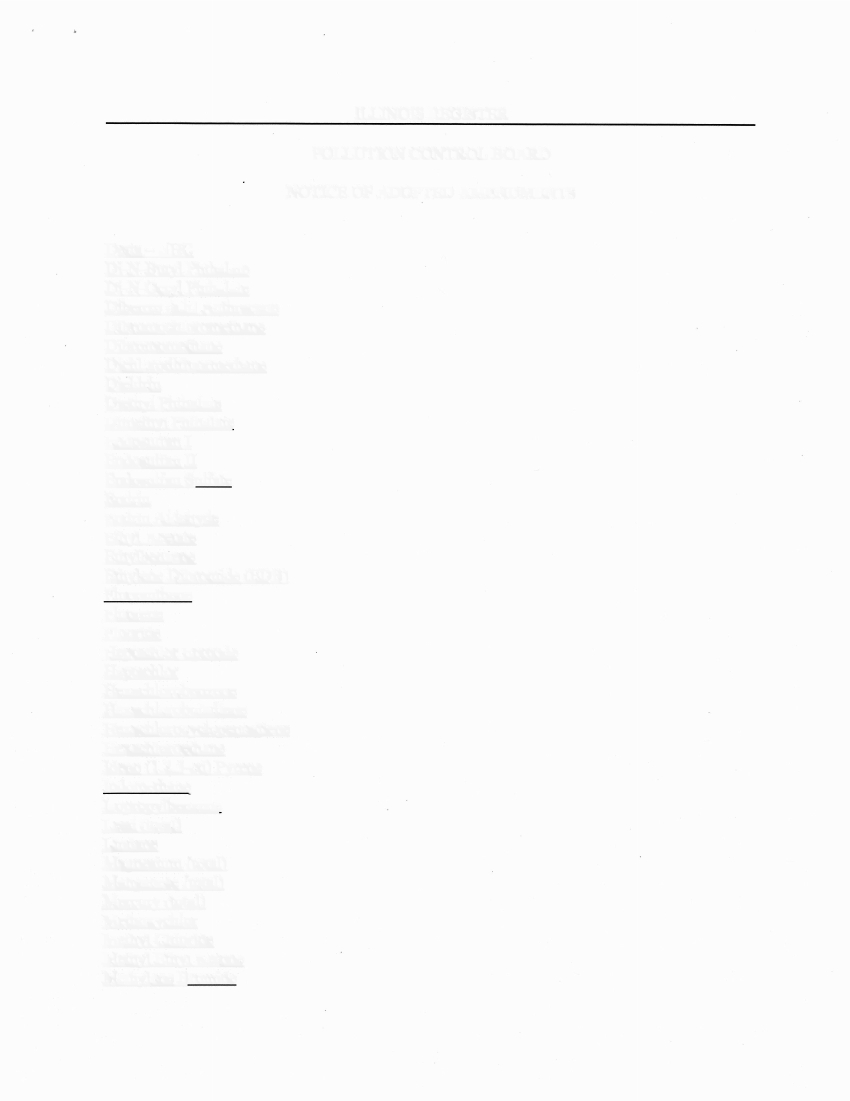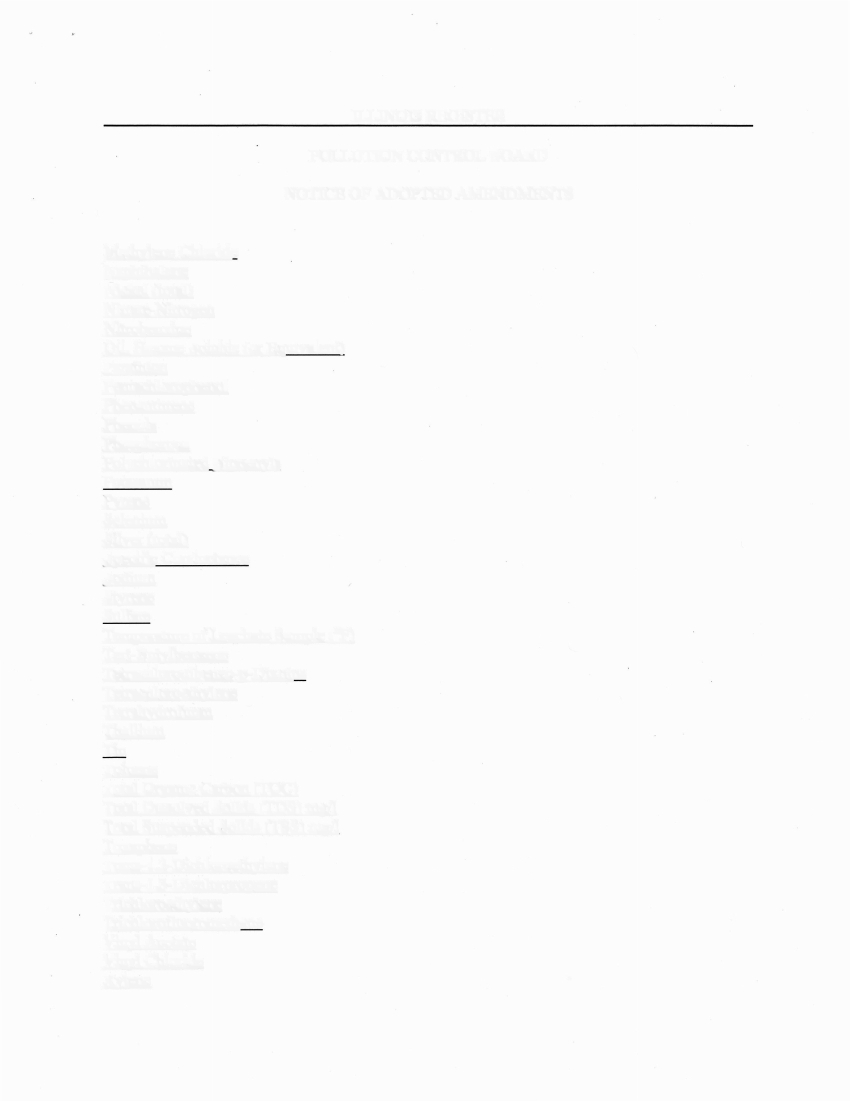OFFICE OF THE SECRETARY OF STATE
JESSE WHITE • Secretary of State
11/28/2007
POLLUTION CONTROL BOARD
JAMES R THOMPSON CENTER 100 W RANDOLPH ST STE 11-500
DOROTHY GUNN
CHICAGO, IL 60601
CLERK'S
IMOIMOVIL,,...OFFICE
DEC 0 3 2007
STATE OF ILLINOIS
Pollution Control Board
Dear DOROTHY GUNN
Your rules Listed below met our codification standards and have been published in
Volume 31, Issue 49 of the Illinois Register, dated 12/07/2007.
ADOPTED RULES
Solid Waste Disposal: General Provisions
35 III. Adm. Code 810
Point Of Contact:Erin Conley
Standards for New Solid Waste Landfills
35 III. Adm. Code 811
Point Of Contact:Erin Conley
Petroleum Underground Storage Tanks (Releases Reported on or After June 24, 2002)
35 III. Adm. Code 734
Point Of Contact:Erin Conley
Page 16167
Page 16172
Page 16151
Petroleum Underground Storage Tanks (Releases Reported September 23, 1994 Through June 23, 2002)
35 III. Adm. Code 732?
Page 16132
Point Of Contact:Erin Conley
General Rules
35 III. Adm. Code 101
?
Page 16110
Point Of Contact:Erin Conley
If you have any questions, you may contact the Administrative Code Division at
(217) 782 - 7017.
Index Department - Administrative Code Division - 111 East Monroe Springfield, IL 62756
ILLINOIS REGISTER
POLLUTION CONTROL BOARD
NOTICE OF ADOPTED AMENDMENTS
1)
Heading of the Part: Solid Waste Disposal: General Provisions
2)
Code Citation: 35 Ill. Adm. Code 810
3)
Section Numbers:
Adopted
Action:
810.104
Amend
4)
Statutory Authority: Implementing Sections 7.2, 21, 21.1, 22, 22.17, and 22.40 and
authorized by Section 27 of the Environmental Protection Act [415 ILCS 5/7.2, 21, 21.1,
22, 22.17, 22.40, and 27].
5)
Effective Date of Amendments: November 27, 2007
6)
Does this rulemaking contain an automatic repeal date? No
7)
Do these amendments contain incorporations by reference? Yes, all materials are
incorporated pursuant to Section 6.02(b) of the Illinois Administrative Procedures Act.
8)
The adopted amendments, including any material incorporated by reference, are on file in
the Board's Chicago office at the James R. Thompson Center, 100 W. Randolph, Suite
11-500 and are available for public inspection.
9)
Notice of Proposal Published in Illinois Register:
August 3, 2007; 31 Ill. Reg. 11107
10)
Has JCAR issued a Statement of Objections to these amendments? No
11)
Differences between proposal and final version: No changes
12)
Have all the changes agreed upon by the agency and JCAR been made as indicated in the
agreements letter issued by JCAR? No changes
13)
Will these amendments replace emergency amendments currently in effect? No
14)
Are there any amendments pending on this Part? No
15)
Summary and Purpose of Amendments:
RECEIVED
NOV 21 2007
SOS-CODE DIV.
ILLINOIS REGISTER
POLLUTION CONTROL BOARD
NOTICE OF ADOPTED AMENDMENTS
For a more detailed description of this rulemaking see the Board's November 15, 2007
final opinion and order in docket R07-8. The adopted amendments in this rulemaking
update the Board's solid waste disposal regulations in order to reflect practical
experience gained through the implementation of those rules and the expanded technical
and scientific knowledge achieved since the Board first adopted these standards in 1990.
This rulemaking is based on a proposal that was filed with the Board on July 27, 2006, by
the Illinois Chapter of the National Solid Wastes Management Association (NSWMA).
Specifically, the amendments to Part 810 update materials incorporated by reference.
16) Information
and questions regarding these adopted amendments shall be directed to:
Tim Fox
Illinois Pollution Control Board
100 W. Randolph 11-500
Chicago, IL 60601
312-814-6085
Copies of the Board's opinions and orders may be requested from the Clerk of the Board
at the address listed in #8 above or by calling 312/814-3620. Please refer to the Docket
number R07-8 in your request. The Board order is also available from the Board's Web
site (www. ipcb . state. il.us)
The full text of the adopted amendments begins on the next page:
ILLINOIS REGISTER
POLLUTION CONTROL BOARD
NOTICE OF ADOPTED AMENDMENTS
TITLE 35: ENVIRONMENTAL PROTECTION
SUBTITLE G: WASTE DISPOSAL
CHAPTER I: POLLUTION CONTROL BOARD
SUBCHAPTER i: SOLID WASTE AND SPECIAL WASTE HAULING
PART 810
SOLID WASTE DISPOSAL: GENERAL PROVISIONS
Section
810.101 Scope
and Applicability
810.102 Severability
810.103 Definitions
810.104 Incorporations
by Reference
810.105 Electronic
Reporting
AUTHORITY: Implementing Sections 7.2, 21, 21.1, 22, 22.17, and 22.40 and authorized by
Section 27 of the Environmental Protection Act [415 ILCS 5/7.2, 21, 21.1, 22, 22.17, 22.40, and
27].
SOURCE: Adopted in R88-7 at 14 Ill. Reg. 15838, effective September 18, 1990; amended in
R93-10 at 18 Ill. Reg. 1268, effective January 13, 1994; amended in R90-26 at 18 Ill. Reg.
12457, effective August 1, 1994; amended in R95-9 at 19 Ill. Reg. 14427, effective September
29, 1995; amended in R96-1 at 20 Ill. Reg. 11985, effective August 15, 1996; amended in R97-
20 at 21 III. Reg. 15825, effective November 25, 1997; amended in R04-5/R04-15 at 28 Ill. Reg.
9090, effective June 18, 2004; amended in R05-1 at 29 Ill. Reg. 5028, effective March 22, 2005;
amended in R06-5/R06-6/R06-7 at 30 Ill. Reg. 4130, effective February 23, 2006; amended in
R06-16/R06-17/R06-18 at 31 III. Reg. 1425, effective December 20, 2006; amended in R07-8 at
31 Ill. Reg.
, effective November 27, 2007.
Section 810.104 Incorporations
by Reference
a) The
Board incorporates the following material by reference:
1) Code
of Federal Regulations:
40 CFR 3.2, as added at 70 Fed. Reg. 59848 (Oct. 13, 2005) (How
Does This Part Provide for Electronic Reporting?), referenced in
Section 810.105.
ILLINOIS REGISTER
POLLUTION CONTROL BOARD
NOTICE OF ADOPTED AMENDMENTS
40 CFR 3.3, as added at 70 Fed. Reg. 59848 (Oct. 13, 2005) (What
Definitions Are Applicable to This Part?), referenced in Section
810.105.
40 CFR 3.10, as added at 70 Fed. Reg. 59848 (Oct. 13, 2005)
(What Are the Requirements for Electronic Reporting to EPA?),
referenced in Section 810.105.
40 CFR 3.2000, as added at 70 Fed. Reg. 59848 (Oct. 13, 2005)
(What Are the Requirements Authorized State, Tribe, and Local
Programs' Reporting Systems Must Meet?), referenced in Section
810.105.
40 CFR 141.40 (2005) (Monitoring Requirements for Unregulated
Contaminants).
Appendix II to 40 CFR 258 (2005), as corrected at 70 Fed. Reg.
11'1150
(August 1, 2005) (List of Hazardous and Organic
Constituents).
40 CFR 258.Appendix I (2006).
40 CFR 258.Appendix II (2006).
2)
American Institute of Certified Public Accountants, 1211 Avenue of the
Americas, New York NY 10036:
Auditing Standards--Current Text, August 1, 1990 Edition.
3)
ASTM. American Society for Testing and Materials, 1976 Race Street,
Philadelphia PA 19103 215-299-5585:
Method D2234-76, "Test Method for Collection of Gross Samples
of Coal," approved 1976.
Method D3987-85, "Standard Test Method for Shake Extraction of
Solid Waste with Water," approved 1985.
ILLINOIS REGISTER
POLLUTION CONTROL BOARD
NOTICE OF ADOPTED AMENDMENTS
4)
GASB. Government Accounting Standards Board, 401 Merritt 7, P.O.
Box 5116, Norwalk CT 06856-5116:
Statement 18.
5)
U.S. Army Corps of Engineers, Publication Department, 2803 52nd Ave.,
Hyattville, Maryland 20781, 301-394-0081:
Engineering Manual 1110-2-1906 Appendix VII, Falling-Head
Permeability Cylinder (1986).
6)
U.S. Government Printing Office, Washington, D.C. 20402, Ph: 202-783-
3238:
"Test Methods for Evaluating Solid Waste, Physical/Chemical
Methods," USEPA publication number EPA-530/SW-846 (Third
Edition, 1986; Revision 6, January 2005), as amended by Update I
(July 1992), II (September 1994), IIA (August 1993), IIB (January
1995), III (December 1996), ILIA (April 1998), and IIIB
(November 2004) (document number 955-001-00000-1).
b)
?
This incorporation includes no later amendments or editions.
(Source: Amended at 31 Ill. Reg. ?
, effective November 27, 2007)
ILLINOIS REGISTER
_Receie
CLEK'S
over)
OFF/CE
DEC 0 3 2007
Pollution
STATE
OF
Control
ILLINOISBoard
POLLUTION CONTROL BOARD
NOTICE OF ADOPTED AMENDMENTS
1)
Heading of the Part: Standards for New Solid Waste Landfills
2)
Code Citation: 35 Ill. Adm. Code 811
3)
Section Numbers: Adopted Action:
811.309 Amend
811.315
Amend
811.318 Amend
811.319
Amend
811.320 Amend
811.APPPENDIX C New Section
4)
Statutory Authority: Implementing Sections 7.2, 21, 21.1, 22, 22.17, and 22.40 and
authorized by Section 27 of the Environmental Protection Act [415 ILCS 5/7.2, 21, 21.1,
22, 22.17, 22.40, and 27].
5)
Effective Date of Amendments: November 27, 2007
6)
Does this rulemaking contain an automatic repeal date? No
7)
Do these amendments contain incorporations by reference? No
8)
The adopted amendments, including any material incorporated by reference, are on file in
the Board's Chicago office at the James R. Thompson Center, 100 W. Randolph, Suite
11-500 and are available for public inspection.
9)
Notice of Proposal Published in Illinois Register:
August 3, 2007; 31 Ill. Reg. 11112
10)
Has JCAR issued a Statement of Objections to these amendments? No
11)
Differences between proposal and final version: At second notice, the Board added
November 27, 2009 as the effective date for the amendments in this rulemaking that
addressed when initial adjustments can be made to the background concentrations of
constituents.
Additionally, the Board corrected typographical and spellings errors in the background
text of the rule.
RECEIVED
NOV 2 1 2007
SOS-CODE DIV.
ILLINOIS REGISTER
POLLUTION CONTROL BOARD
NOTICE OF ADOPTED AMENDMENTS
12)
Have all the changes agreed upon by the agency and JCAR been made as indicated in the
agreements letter issued by JCAR? Yes
13)
Will these amendments replace emergency amendments currently in effect? No
14)
Are there any amendments pending on this Part? No
15)
Summary and Purpose of Amendments:
A more complete description of these adopted amendments may be found in the Board's
opinion and order of November 15, 2007, in Board docket R07-8. This rulemaking
adopts amendments to Part 811 that are intended to update the Board's solid waste
disposal regulations to reflect practical experience gained through the implementation of
those rules and expanded technical and scientific knowledge achieved since the Board
first adopted these standards in 1990. This rulemaking is based on a proposal that was
filed with the Board on July 27, 2006, by the Illinois Chapter of the National Solid
Wastes Management Association (NSWMA) with the concurrence of the Illinois
Environmental Protection Agency (Agency).
The amendments adopted in this rulemaking include changes that pertain to issues
including leachate monitoring, hydrogeologic site investigation, groundwater monitoring
systems, and groundwater quality standards.
The amendments to the leachate monitoring include adding a list of 202 constituents to be
monitored. The amendments also add a minimum number of leachate monitoring
locations at landfill units. For the first two years of landfill operation, the amendments
change the frequency of leachate monitoring frequency from quarterly to semi-annual
monitoring. The adopted amendments also require sampling from each monitoring
location at least once every two years.
At Section 811.315(e)(1)(G)(i), the Board replaced the reference in the rules to 'public or
food processing water supply standard at 35 Ill. Adm. Code 302' with a reference to the
groundwater standards found at 35 Ill. Adm. Code 620. This amendment replaces the list
of constituents under public or food processing water supply standards with a more
comprehensive list of constituents under the Board's groundwater standards.
The amendments to the groundwater monitoring systems address the depth of monitoring
wells. Specifically, the final amendments require an operator to measure the depth of
groundwater monitoring wells that do not contain dedicated pumps on an annual basis.
The amendments also require that, at groundwater monitoring wells containing dedicated
ILLINOIS REGISTER
POLLUTION CONTROL BOARD
NOTICE OF ADOPTED AMENDMENTS
pumps, the operator must measure the depth of the well every five years or when the
pump is serviced.
Additional amendments to monitoring requirements include adding a specific list of
indicator constituents, adding a specific list of organic chemicals for which groundwater
must be monitored, and increasing the frequency of the monitoring for the specified
organic parameters.
The changes to the assessment monitoring provisions under Section 811.319(b) include
specifying deadlines for submission and implementation of an assessment monitoring
plan.
The amendments adopt a number of changes to the groundwater quality standard
provisions under Section 811.320. These changes replace references to public water
supply standards with references to groundwater standards, clarify the establishment of
background concentrations, and update statistical analysis procedures.
16) Information
and questions regarding these adopted amendments shall be directed to:
Tim Fox
Illinois Pollution Control Board
100 W. Randolph 11-500
Chicago, IL 60601
312-814-6085
Copies of the Board's opinions and orders may be requested from the Clerk of the Board
at the address listed in #8 above or by calling 312/814-3620. Please refer to the Docket
number R07-8 in your request. The Board order is also available from the Board's Web
site (www. ipcb . state. il.us)
The full text of the ado • ted amendments be • ins on the next e a . e:
ILLINOIS REGISTER
POLLUTION CONTROL BOARD
NOTICE OF ADOPTED AMENDMENTS
TITLE 35: ENVIRONMENTAL PROTECTION
SUBTITLE G: WASTE DISPOSAL
CHAPTER I: POLLUTION CONTROL BOARD
SUBCHAPTER i: SOLID WASTE AND SPECIAL WASTE HAULING
PART 811
STANDARDS FOR NEW SOLID WASTE LANDFILLS
SUBPART A: GENERAL STANDARDS FOR ALL LANDFILLS
Section
?
811.101?
Scope and Applicability
?
811.102?
Location Standards
?
811.103
?
Surface Water Drainage
?
811.104?
Survey Controls
?
811.105
?
Compaction
?
811.106?
Daily Cover
?
811.107
?
Operating Standards
?
811.108?
Salvaging
?
811.109?
Boundary Control
?
811.110
?
Closure and Written Closure Plan
?
811.111?
Postelosure Maintenance
?
811.112
?
Recordkeeping Requirements for MSWLF Units
?
811.113
?
Electronic Reporting
SUBPART B: INERT WASTE LANDFILLS
Section
?
811.201
?
Scope and Applicability
?
811.202
?
Determination of Contaminated Leachate
?
811.203
?
Design Period
?
811.204
?
Final Cover
?
811.205?
Final Slope and Stabilization
?
811.206
?
Leachate Sampling
?
811.207?
Load Checking
SUBPART C: PUTRESCIBLE AND CHEMICAL WASTE LANDFILLS
Section
?
811.301
?
Scope and Applicability
?
811.302
?
Facility Location
ILLINOIS REGISTER
POLLUTION CONTROL BOARD
NOTICE OF ADOPTED AMENDMENTS
811.303
811.304
811.305
811.306
811.307
811.308
811.309
811.310
811.311
811.312
811.313
811.314
811.315
811.316
811.317
811.318
811.319
811.320
811.321
811.322
811.323
811.324
811.325
811.326
Design Period
Foundation and Mass Stability Analysis
Foundation Construction
Liner Systems
Leachate Drainage System
Leachate Collection System
Leachate Treatment and Disposal System
Landfill Gas Monitoring
Landfill Gas Management System
Landfill Gas Processing and Disposal System
Intermediate Cover
Final Cover System
Hydrogcological Hydrogeologic Site Investigations
Plugging and Sealing of Drill Holes
Groundwater Impact Assessment
Design, Construction, and Operation of Groundwater Monitoring Systems
Groundwater Monitoring Programs
Groundwater Quality Standards
Waste Placement
Final Slope and Stabilization
Load Checking Program
Corrective Action Measures for MSWLF Units
Selection of remedy for MSWLF Units
Implementation of the corrective action program at MSWLF Units
SUBPART D: MANAGEMENT OF SPECIAL WASTES AT LANDFILLS
Section
811.401 Scope and Applicability
811.402 Notice
to Generators and Transporters
811.403 Special
Waste Manifests
811.404 Identification Record
811.405 Recordkeeping
Requirements
811.406 Procedures
for Excluding Regulated Hazardous Wastes
SUBPART E: CONSTRUCTION QUALITY ASSURANCE PROGRAMS
Section
811.501
Scope
and Applicability
811.502
Duties
and Qualifications of Key Personnel
811.503
Inspection
Activities
ILLINOIS REGISTER
POLLUTION CONTROL BOARD
NOTICE OF ADOPTED AMENDMENTS
?
811.504?
Sampling Requirements
?
811.505?
Documentation
?
811.506?
Foundations and Subbases
?
811.507?
Compacted Earth Liners
?
811.508?
Geomembranes
?
811.509?
Leachate Collection Systems
SUBPART G: FINANCIAL ASSURANCE
Section
?
811.700
?
Scope, Applicability and Definitions
?
811.701?
Upgrading Financial Assurance
?
811.702
?
Release of Financial Institution
?
811.703?
Application of Proceeds and Appeals
?
811.704
?
Closure and Postclosure Care Cost Estimates
?
811.705?
Revision of Cost Estimate
?
811.706?
Mechanisms for Financial Assurance
?
811.707?
Use of Multiple Financial Mechanisms
?
811.708?
Use of a Financial Mechanism for Multiple Sites
?
811.709
?
Trust Fund for Unrelated Sites
?
811.710?
Trust Fund
?
811.711
?
Surety Bond Guaranteeing Payment
?
811.712
?
Surety Bond Guaranteeing Performance
?
811.713?
Letter of Credit
?
811.714
?
Closure Insurance
?
811.715?
Self-Insurance for Non-commercial Sites
?
811.716
?
Local Government Financial Test
?
811.717?
Local Government Guarantee
?
811.718?
Discounting
?
811.719?
Corporate Financial Test
?
811.720?
Corporate Guarantee
811.APPENDIX A Financial Assurance Forms
ILLUSTRATION A Trust Agreement
ILLUSTRATION B Certificate of Acknowledgment
ILLUSTRATION C Forfeiture Bond
ILLUSTRATION D Performance Bond
ILLUSTRATION E Irrevocable Standby Letter of Credit
ILLUSTRATION F Certificate of Insurance for Closure and/or Postclosure Care
ILLUSTRATION G Operator's Bond Without Surety
ILLINOIS REGISTER
POLLUTION CONTROL BOARD
NOTICE OF ADOPTED AMENDMENTS
ILLUSTRATION H Operator's Bond With Parent Surety
ILLUSTRATION I Letter from Chief Financial Officer
811.APPENDIX
B
Section-by-Section correlation between the Standards of the RCRA
Subtitle D MSWLF regulations and the Board's nonhazardous waste
landfill regulations.
811.APPENDIX C List of Leachate Monitoring Parameters
AUTHORITY: Implementing Sections 7.2, 21, 21.1, 22, 22.17, and 22.40 and authorized by
Section 27 of the Environmental Protection Act [415 ILCS 5/7.2, 21, 21.1, 22, 22.17, 22.40, and
27].
SOURCE: Adopted in R88-7 at 14 Ill. Reg. 15861, effective September 18, 1990; amended in
R92-19 at 17 Ill. Reg. 12413, effective July 19, 1993; amended in R93-10 at 18 Ill. Reg. 1308,
effective January 13, 1994; expedited correction at 18 Ill. Reg. 7504, effective July 19, 1993;
amended in R90-26 at 18 Ill. Reg. 12481, effective August 1, 1994; amended in R95-13 at 19 Ill.
Reg. 12257, effective August 15, 1995; amended in R96-1 at 20 Ill. Reg. 12000, effective
August 15, 1996; amended in R97-20 at 21 Ill. Reg.15831, effective November 25, 1997;
amended in R98-9 at 22 Ill. Reg.11491, effective June 23, 1998; amended in R99-1 at 23 Ill.
Reg. 2794, effective February 17, 1999; amended in R98-29 at 23 Ill. Reg.6880, effective July 1,
1999; amended in R04-5/R04-15 at 28 Ill. Reg. 9107, effective June 18, 2004; amended in R05-1
at 29 Ill. Reg. 5044, effective March 22, 2005; amended in R06-5/R06-6/R06-7 at 30 Ill. Reg.
4136, effective February 23, 2006; amended in R06-16/R06-17/R06-18 at 31 Ill. Reg. 1435,
effective December 20, 2006; amended in R07-8 at 31 Ill. Reg.
?
, effective
November 27, 2007.
SUBPART C: PUTRESCIBLE AND CHEMICAL WASTE LANDFILLS
Section 811.309
?
Leachate Treatment and Disposal Systems
a)
?
Leachate shall be allowed to flow freely from the drainage and collection system.
The operator is responsible for the operation of a leachate management system
designed to handle all leachate as it drains from the collection system. The
leachate management system shall consist of any combination of storage,
treatment, pretreatment, and disposal options designed and constructed in
compliance with the requirements of this Section.
ILLINOIS REGISTER
POLLUTION CONTROL BOARD
NOTICE OF ADOPTED AMENDMENTS
b) The
leachate management system shall consist of any combination of multiple
treatment and storage structures, to allow the management and disposal of
leachate during routine maintenance and repairs.
c) Standards
for Onsite Treatment and Pretreatment
1)
All onsite treatment or pretreatment systems shall be considered part of
the facility.
2)
The onsite treatment or pretreatment system shall be designed in
accordance with the expected characteristics of the leachate. The design
may include modifications to the system necessary to accommodate
changing leachate characteristics.
3)
The onsite treatment or pretreatment system shall be designed to function
for the entire design period.
4)
All of the facility's unit operations, tanks, ponds, lagoons and basins shall
be designed and constructed with liners or containment structures to
control seepage to groundwater.
5)
All treated effluent discharged to waters of the State shall meet the
requirements of 35 Ill. Adm. Code 309.
6)
The treatment system shall be operated by an operator certified under the
requirements of 35 Ill. Adm. Code 312.
d) Standards
for Leachate Storage Systems
1) Except
as otherwise provided in subsection (d)(6) of this Section, the
leachate storage facility must be able to store a minimum of at least five
days' worth of accumulated leachate at the maximum generation rate used
in designing the leachate drainage system in accordance with Section
811.307. The minimum storage capacity may be built up over time and in
stages, so long as the capacity for five consecutive days of accumulated
leachate is available at any time during the design period of the facility.
2) All
leachate storage tanks shall be equipped with secondary containment
systems equivalent to the protection provided by a clay liner 0.61 meter (2
ILLINOIS REGISTER
POLLUTION CONTROL BOARD
NOTICE OF ADOPTED AMENDMENTS
feet thick) having a permeability no greater than 10-7
centimeters per
second.
3)
Leachate storage systems shall be fabricated from material compatible
with the leachate expected to be generated and resistant to temperature
extremes.
4)
The leachate storage system shall not cause or contribute to a malodor.
5)
The leachate drainage and collection system shall not be used for the
purpose of storing leachate.
A facility may have less than five days' worth of storage capacity for
accumulated leachate as required by subsection (d)(1) of this Section, if
the owner or operator of the facility demonstrates that multiple treatment,
storage and disposal options in the facility's approved leachate
management system developed in accordance with subsection (b) of this
Section will achieve equivalent performance. Such options shall consist
of not less than one day's worth of storage capacity for accumulated
leachate plus at least two alternative means of managing accumulated
leachate through treatment or disposal, or both treatment and disposal,
each of which means is capable of treating or disposing of all leachate
generated at the maximum generation rate on a daily basis.
e) Standards
for Discharge to an Offsite Treatment Works
1) Leachate
may be discharged to an offsite treatment works that meets the
following requirements:
A)
All discharges of effluent from the treatment works shall meet the
requirements of 35 Ill. Adm. Code 309.
B)
The treatment systems shall be operated by an operator certified
under the requirements of 35 Ill. Adm. Code 312.
C)
No more than 50 percent of the average daily influent flow can be
attributable to leachate from the solid waste disposal facility.
Otherwise, the treatment works shall be considered a part of the
solid waste disposal facility.
ILLINOIS REGISTER
POLLUTION CONTROL BOARD
NOTICE OF ADOPTED AMENDMENTS
2)
The operator is responsible for securing permission from the offsite
treatment works for authority to discharge to the treatment works.
3)
All discharges to a treatment works shall meet the requirements of 35 Ill.
Adm. Code 310.
4)
Pumps, meters, valves and monitoring stations that control and monitor
the flow of leachate from the unit and which are under the control of the
operator shall be considered part of the facility and shall be accessible to
the operator at all times.
5)
Leachate shall be allowed to flow into the sewage system at all times;
however, if access to the treatment works is restricted or anticipated to be
restricted for longer than five days, then an alternative leachate
management system shall be constructed in accordance with subsection
(c).
6)
Where leachate is not directly discharged into a -sewerage sewage system,
the operator shall provide storage capacity sufficient to transfer all
leachate to an offsite treatment works. The storage system shall meet the
requirements of subsection (d).
f) Standards
for Leachate Recycling Systems
1) Leachate
recycling systems may be utilized only at permitted waste
disposal units that meet the following requirements:
A)
The unit must have a liner designed, constructed and maintained to
meet the minimum standards of Section 811.306.
B)
The unit must have a leachate collection system in place and
operating in accordance with Section 811.307.
C)
A gas management system, equipped with a mechanical device
such as a compressor to withdraw gas, must be implemented to
control odors and prevent migration of methane in accordance with
Section 811.311.
ILLINOIS REGISTER
POLLUTION CONTROL BOARD
NOTICE OF ADOPTED AMENDMENTS
D)
?
The topography must be such that any accidental leachate runoff
can be controlled by ditches, berms or other equivalent control
means.
2)
Leachate shall not be recycled during precipitation events or in volumes
large enough to cause runoff or surface seeps.
3)
The amount of leachate added to the unit shall not exceed the ability of the
waste and cover soils to transmit leachate flow downward. All other
leachate shall be considered excess leachate, and a leachate management
system capable of disposing of all excess leachate must be available.
4)
The leachate storage and distribution system shall be designed to avoid
exposure of leachate to air unless aeration or functionally equivalent
devices are utilized.
5)
The distribution system shall be designed to allow leachate to be evenly
distributed beneath the surface over the recycle area.
6)
Daily and intermediate cover shall be permeable to the extent necessary to
prevent the accumulation of water and formation of perched watertables
and gas buildup; alternatively cover shall be removed prior to additional
waste placement.
7)
Daily and intermediate cover shall slope away from the perimeter of the
site to minimize surface discharges.
Leachate Monitoring
1)
?
Representative samples of leachate shall be collected from each
established leachate monitoring location and tested in accordance with
subsection (g)(5) and tested for the parameters referenced in subsections
(g)(2)(G) and (g)(3)(D) at a frequency of once per quarter until such time
any r ason insufficient leachate is obtained to yield a sample for testing
toward the eight quarters' leachate monitoring requirement. Ther after,
the frequency of testing shall be changed to semi annual for any
ILLINOIS REGISTER
POLLUTION CONTROL BOARD
NOTICE OF ADOPTED AMENDMENTS
operation. However, the. The Agency may, by permit condition, require
additional, or allow less, leachate sampling and testing as necessary to
ensure compliance with this Section and Sections 811.312, 811.317, and
811.319.
2) Discharges
of leachate from units that dispose of putrescible wastes shall
be tested for the following constituents prior to treatment or pretreatment:
A)
Five day biochemical oxygen demand (BOD5);
B)
Chemical oxygen demand;
C)
Total Suspended Solids;
D)
Total Iron;
E)
pH;
F)
Any other constituents listed in the operator's National Pollution
Discharge Elimination System (NPDES) discharge permit,
pursuant to 35 Ill. Adm. Code 304, or required by a publicly
owned treatment works, pursuant to 35 Ill. Adm. Code 310; and
G)
All of the indicator constituents chosen in accordance with Section
811.319(a)(2)(B) and used by the operator for gr undwater
monitoring the monitoring parameters listed in Section
811.Appendix C. unless an alternate monitoring list has been
approved by the Agency.
3) Discharges
of leachate from units which dispose only chemical wastes
shall be monitored for constituents determined by the characteristics of the
chemical waste to be disposed of in the unit. They shall include, as a
minimum:
A)
pH;
B)
Total Dissolved Solids;
ILLINOIS REGISTER
POLLUTION CONTROL BOARD
NOTICE OF ADOPTED AMENDMENTS
C)
Any other constituents listed in the operator's NPDES discharge
permit, pursuant to 35 Ill. Adm. Code 304, or required by a
publicly owned treatment works, pursuant to 35 Ill. Adm. Code
310; and
D)
All of the indicator constituents chosen in accordance with Section
811.319(a)(2)(B) and used by the operator for groundwater
monitoring the monitoring parameters listed in Section
811.Appendix C, unless an alternate monitoring list has been
aprop 1 by the Agency.
A network of leachate monitoring locations shall be established, capable
of characterizing the leachate produced by the unit. Unless an alternate
network has been approved by the Agency, the network of leachate
monitoring locations shall include:
A)
.
At least four leachate monitoring locations: and
al At
least one leachate monitoring location for every 25 acres within
the unit's waste boundaries.
51 Leachate monitoring shall be performed at least once every six months
and each established leachate monitoring location shall be monitored at
least once every two years.
h) Time
of Operation of the Leachate Management System
1)
The operator shall collect and dispose of leachate for a minimum of five
years after closure and thereafter until treatment is no longer necessary.
2)
Treatment is no longer necessary if the leachate constituents do not exceed
the wastewater effluent standards in 35 Ill. Adm. Code 304.124, 304.125,
304.126 and do not contain a BOD
5 concentration greater than 30 mg/L
for six consecutive months.
3)
Leachate collection at a MSWLF unit shall be continued for a minimum
period of 30 years after closure, except as otherwise provided by
subsections (h)(4) and (h)(5), below.
ILLINOIS REGISTER
POLLUTION CONTROL BOARD
NOTICE OF ADOPTED AMENDMENTS
4)
The Agency may reduce the leachate collection period at a MSWLF unit
upon a demonstration by the owner or operator that the reduced period is
sufficient to protect human health and environment.
5)
The owner or operator of a MSWLF unit shall petition the Board for an
adjusted standard in accordance with Section 811.303, if the owner or
operator seeks a reduction of the postclosure care monitoring period for all
of the following requirements:
i)
Inspection and maintenance (Section 811.111);
ii)
Leachate collection (Section 811.309);
iii)
Gas monitoring (Section 811.130); and
iv)
Groundwater monitoring (Section 811.319).
BOARD NOTE: Subsection (h) is derived from 40 CFR 258.61 (1992).
(Source: Amended at 31 III. Reg.
, effective November 27, 2007)
Section 811.315 Hydrogeologic Site Investigations
a) Purpose
The operator shall conduct a hydrogeologic investigation to develop
hydrogeologic information for the following uses:
1)
Provide information to perform a groundwater impact assessment; and
2)
Provide information to establish a groundwater monitoring system.
b) General Requirements
1) The
investigation shall be conducted in a minimum of three phases prior to
submission of any application to the Agency for a permit to develop and
operate a landfill facility.
ILLINOIS REGISTER
POLLUTION CONTROL BOARD
NOTICE OF ADOPTED AMENDMENTS
2)
The study area shall consist of the entire area occupied by the facility and
any adjacent related areas, if necessary for the purposes of the
hydrogeological investigation set forth in subsection (a).
3)
All borings shall be sampled continuously at all recognizable points of
geologic variation, except that where continuous sampling is impossible or
where non-continuous sampling can provide equivalent information,
samples shall be obtained at intervals no greater than 1.52 meters (five
feet) in homogeneous strata.
c) Minimum Requirements For for a Phase I Investigation
1) The operator shall conduct a Phase I Investigation to develop the
following information:
A)
Climatic aspects of the study area;
B)
The regional and study area geologic setting, including a
description of the geomorphology and stratigraphy of the area;
C)
The regional groundwater regime including water table depths and
aquifer characteristics; and
D)
Information for the purpose of designing a Phase II Hydrogeologic
Investigation.
2) Specific Requirements
A)
The regional hydrogeologic setting of the unit shall be established
by using material available from all possible sources, including,
but not limited to, the Illinois Scientific Surveys, the Agency, other
State and Federal organizations, water well drilling logs, and
previous investigations.
B)
A minimum of one continuously sampled boring shall be drilled on
the site, as close as feasible to the geographic center, to determine
if the available regional hydrogeologic setting information is
accurate and to characterize the site-specific hydrogeology to the
extent specified by this phase of the investigation. The boring
ILLINOIS REGISTER
POLLUTION CONTROL BOARD
NOTICE OF ADOPTED AMENDMENTS
shall extend at least 15.2 meters (50 feet) below the bottom of the
uppermost aquifer or through the full depth of the confining layer
below the uppermost aquifer, or to bedrock, if the bedrock is below
the upper most aquifer, whichever elevation is higher. The
locations of any additional borings, required under this subsection,
may be chosen by the investigator, but shall be sampled
continuously.
d) Minimum
Requirements For A for a Phase II Investigation
1) Information
to be developed
Using the information developed in the Phase I survey, a Phase II study
shall be conducted to collect the site-specific information listed below as
needed to augment data collected during the Phase I investigation and to
prepare for the Phase III investigation:
A)
Structural characteristics and distribution of underlying strata
including bedrock;
B)
Chemical and physical properties including, but not limited to,
lithology, mineralogy, and hydraulic charactcrisitics characteristics
of underlying strata including those below the uppermost aquifer;
C)
Soil charactcrisitics characteristics, including soil types,
distribution, geochemical and geophysical characteristics;
D)
The hydraulic conductivities of the uppermost aquifer and all strata
above it;
E)
The vertical extent of the uppermost aquifer;
F)
The direction and rate of groundwater flow.
2) Specific
Requirements
A) One
boring shall be located as close as feasible to the
topographical high point, and another shall be located as close as
feasible to the topographical low point of the study area.
ILLINOIS REGISTER
POLLUTION CONTROL BOARD
NOTICE OF ADOPTED AMENDMENTS
B)
At least one boring shall be at or near each corner of the site.
Where the property is irregularly shaped the borings shall be
located near the boundary in a pattern and spacing necessary to
obtain data over the entire study area.
C)
Additional borings may be located at intermediate points at
locations and spacings necessary to establish the continuity of the
stratigraphic units.
D)
Piezometers and groundwater monitoring wells shall be established
to determine the direction and flow characteristics of the
groundwater in all strata and extending down to the bottom of the
uppermost aquifer. Groundwater samples taken from such
monitoring wells shall be used to develop preliminary information
needed for establishing background concentrations in accordance
with subsection (e)(1)(G).
E)
Other methods may be utilized to confirm or accumulate additional
information. Such methods may be used only as a supplement to,
not in lieu of, site-specific boring information. Other methods
include, but are not limited to, geophysical well logs, geophysical
surveys, aerial photography, age dating, and test pits.
e) Minimum
Standards For A for a Phase III Investigation
1) Using
the information developed during the Phase I and Phase II
Investigations, the operator shall conduct a Phase III Investigation. This
investigation shall be conducted to collect or augment the site-specific
information needed to carry out the following:
A)
Verification and rcconcilation reconciliation of the information
collected in the Phase I and II investigations;
B)
Characterization of potential pathways for contaminant migration;
C)
Correlation of stratigraphic units between borings;
ILLINOIS REGISTER
POLLUTION CONTROL BOARD
NOTICE OF ADOPTED AMENDMENTS
D) Continuity
of petrographic features including, but not limited to,
sorting, grain size distribution, cementation and hydraulic
conductivity;
E) Identification
of zones of potentially high hydraulic conductivity;
F) Identification of the confining layer, if present;
G) Concentrations of chemical constituents present in the groundwater
below the unit, down to the bottom of the uppermost aquifer, using
a broad range of chemical analysis and detection procedures such
as, gas chromatographic and mass spectrometric scanning.
However, additional measurements and procedures shall be carried
out to establish background concentrations, in accordance with
Section 811.320(d), for:
i)
Any constituent for which there is a public or food
processing water supply standard at 35 Ill. Adm. Code
302620 established by the Board and which is expected to
appear in the leachate; and
ii)
Any other constituent for which there is no Board-
established standard, but which is expected to appear in the
leachate at concentrations above PQL, as defined in Section
811.319(a)(4)(A) for that constituent;
H) Characterization of the seasonal and temporal, naturally and
artifically artificially induced, variations in groundwater quality
and groundwater flow; and
I) Identification of unusual or unpredicted geologic features,
including: fault zones, fracture traces, facies changes, solution
channels, buried stream deposits, cross cutting structures and other
geologic features that may affect the ability of the operator to
monitor the groundwater or predict the impact of the disposal
facility on groundwater.
2) In
addition to the specific requirements applicable to phase Phase I and II
investigations, the operator shall Collect information needed to meet the
ILLINOIS REGISTER
POLLUTION CONTROL BOARD
NOTICE OF ADOPTED AMENDMENTS
minimum standards of a phase Phase III investigation by using methods
that may include, but not limited to excavation of test pits, additional
borings located at intermediate points between boreholes placed during
phase Phase I and II investigations, placement of piezometers and
monitoring wells, and institution of procedures for sampling and analysis.
0 The
operator may conduct the hydrogeologic investigation in any number of
alternative ways provided that the necessary information is collected in a
systematic sequence consisting of at least three phases that is equal to or superior
to the investigation procedures of this Section.
(Source: Amended at 31 Ill. Reg. , effective November 27, 2007)
Section 811.318 Design, Construction, and Operation of Groundwater
Monitoring Systems
a)
All potential sources of discharges to groundwater within the facility, including,
but not limited to, all waste disposal units and the leachate management system,
shall be identified and studied through a network of monitoring wells operated
during the active life of the unit and for the time after closure specified in
accordance with Section 811.319. Monitoring wells designed and constructed as
part of the monitoring network shall be maintained along with records that
include, but are not limited to, exact well location, well size, type of well, the
design and construction practice used in its installation and well and screen
depths.
b)
Standards for the Location of Monitoring Points
1)
A network of monitoring points shall be established at sufficient locations
downgradient with respect to groundwater flow and not excluding the
downward direction, to detect any discharge of contaminants from any
part of a potential source of discharge.
2)
Monitoring wells shall be located in stratigraphic horizons that could serve
as contaminant migration pathways.
3)
Monitoring wells shall be established as close to the potential source of
discharge as possible without interfering with the waste disposal
operations, and within half the distance from the edge of the potential
ILLINOIS REGISTER
POLLUTION CONTROL BOARD
NOTICE OF ADOPTED AMENDMENTS
source of discharge to the edge of the zone of attenuation downgradient,
with respect to groundwater flow, from the source.
4)
The network of monitoring points of several potential sources of discharge
within a single facility may be combined into a single monitoring network,
provided that discharges from any part of all potential sources can be
detected.
5)
A minimum of at least one monitoring well shall be established at the edge
of the zone of attenuation and shall be located downgradient with respect
to groundwater flow and not excluding the downward direction, from the
unit. Such well or wells shall be used to monitor any statistically
significant increase in the concentration of any constituent, in accordance
with Section 811.320(e) and shall be used for determining compliance
with an applicable groundwater quality standard of Section 811.320. An
observed statistically significant increase above the applicable
groundwater quality standards of Section 811.320 in a well located at or
beyond the compliance boundary shall constitute a violation.
c)
Maximum Allowable Predicted Concentrations
The operator shall use the same calculation methods, data, and assumptions as
used in the groundwater impact assessment to predict the concentration over time
and space of all constituents chosen to be monitored in accordance with Section
811.319 at all monitoring points. The predicted values shall be used to establish
the maximum allowable predicted concentrations (MAPC) at each monitoring
point. The MAPCs calculated in this subsection shall be applicable within the
zone of attenuation.
d)
Standards for Monitoring Well Design and Construction
1)
All monitoring wells shall be cased in a manner that maintains the
integrity of the bore hole. The casing material shall be inert so as not to
affect the water sample. Casing requiring solvent-cement type couplings
shall not be used.
2)
Wells shall be screened to allow sampling only at the desired interval.
Annular space between the borehole wall and well screen section shall be
packed with gravel sized to avoid clogging by the material in the zone
being monitored. The slot size of the screen shall be designed to minimize
ILLINOIS REGISTER
POLLUTION CONTROL BOARD
NOTICE OF ADOPTED AMENDMENTS
clogging. Screens shall be fabricated from material expected to be inert
with respect to the constituents of the groundwater to be sampled.
3)
Annular space above the well screen section shall be sealed with a
relatively impermeable, expandable material such as a cement/bentonite
grout, which does not react with or in any way affect the sample, in order
to prevent contamination of samples and groundwater and avoid
interconnections. The seal shall extend to the highest known seasonal
groundwater level.
4)
The annular space shall be back-filled with expanding cement grout from
an elevation below the frost line and mounded above the surface and
sloped away from the casing so as to divert surface water away.
5)
The annular space between the upper and lower seals and in the
unsaturated zone may be back-filled with uncontaminated cuttings.
6)
All wells shall be covered with vented caps and equipped with devices to
protect against tampering and damage.
7)
All wells shall be developed to allow free entry of water, minimize
turbidity of the sample, and minimize clogging.
8)
The transmissivity of the zone surrounding all well screens shall be
established by field testing techniques.
9)
Other sampling methods and well construction techniques may be utilized
if they provide equal or superior performance to the requirements of this
subsection.
e)?
Standards for Sample Collection and Analysis
1) The groundwater monitoring program shall include consistent sampling
and analysis procedures to assure that monitoring results can be relied
upon to provide data representative of groundwater quality in the zone
being monitored.
2)?
The operator shall utilize procedures and techniques to insure that
collected samples are representative of the zone being monitored and that
ILLINOIS REGISTER
POLLUTION CONTROL BOARD
NOTICE OF ADOPTED AMENDMENTS
prevent cross contamination of samples from other monitoring wells or
from other samples. At least 95 percent of a collected sample shall consist
of groundwater from the zone being monitored.
3)
The operator shall establish a quality assurance program that provides
quantitative detection limits and the degree of error for analysis of each
chemical constituent.
4)
The operator shall establish a sample preservation and shipment procedure
that maintains the reliability of the sample collected for analysis.
5)
The operator shall institute a chain of custody procedure to prevent
tampering and contamination of the collected samples prior to completion
of analysis.
6)
At a minimum, the operator shall sample the following parameters at all
wells at the time of sample collection and immediately before filtering and
preserving samples for shipment:
A)
The elevation of the water table;
B)
The depth of the well below ground;
GB) pH;
DC) The temperature of the sample; and
ED) Specific Conductance.
The operator must measure the depth of the well below ground on an
annual basis, at wells that do not contain dedicated pumps. The operator
must measure the depth of the well below ground every 5 years, or
whenever the pump is pulled. in wells with dedicated pumps.
78) In addition to the requirements of subsections (e)(1) through (e)(6), the
following requirements shall apply to MSWLF units:
A) Each time groundwater is sampled, an owner or operator of a
MSWLF unit shall:
ILLINOIS REGISTER
POLLUTION CONTROL BOARD
NOTICE OF ADOPTED AMENDMENTS
i)
Measure the groundwater elevations in each well
immediately prior to purging; and
ii)
Determine the rate and direction of ground-water flow.
B) An
owner or operator shall measure groundwater elevations in wells which
monitor the same waste management area within a period of time short enough to
avoid temporal variations in groundwater flow which could preclude accurate
determination of groundwater flow rate and direction.
BOARD NOTE: Subsection (e)(7) is derived from 40 CFR 258.53(d) (1992).
(Source: Amended at 31 Ill. Reg.
, effective November 27, 2007)
Section 811.319 Groundwater
Monitoring Programs
a) Detection
Monitoring Program
Any use of the term maximum allowable predicted concentration in this Section is
a reference to Section 811.318(c). The operator shall implement a detection
monitoring program in accordance with the following requirements:
1) Monitoring
Schedule and Frequency
A) The
monitoring period shall begin as soon as waste is placed into
the unit of a new landfill or within one year of the effective date of
this Part for an existing landfill. Monitoring shall continue for a
minimum period of fifteen years after closure, or in the case of
MSWLF units, a minimum period of 30 years after closure, except
as otherwise provided by subsection (a)(1)(C) of this Section. The
operator shall sample all monitoring points for all potential sources
of contamination on a quarterly basis except as specified in
subsection (a)(3), for a period of five years from the date of
issuance of the initial permit for significant modification under 35
Ill. Adm. Code 814.104 or a permit for a new unit pursuant to 35
Ill. Adm. Code 813.104. After the initial five-year period, the
sampling frequency for each monitoring point shall be reduced to a
ILLINOIS REGISTER
POLLUTION CONTROL BOARD
NOTICE OF ADOPTED AMENDMENTS
semi-annual basis, provided the operator has submitted the
certification described in 35 Ill. Adm. Code 813.304(b).
Alternatively, after the initial five-year period, the Agency shall
allow sampling on a semi-annual basis where the operator
demonstrates that monitoring effectiveness has not been
compromised, that sufficient quarterly data has been collected to
characterize groundwater, and that leachate from the monitored
unit does not constitute a threat to groundwater. For the purposes
of this Section, the source shall be considered a threat to
groundwater if the results of the monitoring indicate either that the
concentrations of any of the constituents monitored within the zone
of attenuation is above the maximum allowable predicted
concentration for that constituent or, for existing landfills, subject
to 35 Ill. Adm. Code 814, Subpart D, that the concentration of any
constituent has exceeded the applicable standard at the compliance
boundary as defined in 35 Ill. Adm. Code 814.402(b)(3).
B) Beginning
fifteen years after closure of the unit, or five years after
all other potential sources of discharge no longer constitute a threat
to groundwater, as defined in subsection (a)(1)(A), the monitoring
frequency may change on a well by well basis to an annual
schedule if either of the following conditions exist. However,
monitoring shall return to a quarterly schedule at any well where a
statistically significant increase is determined to have occurred in
accordance with Section 811.320(e), in the concentration of any
constituent with respect to the previous sample.
i)
All constituents monitored within the zone of attenuation
have returned to a concentration less than or equal to ten
percent of the maximum allowable predicted concentration;
or
ii)
All constituents monitored within the zone of attenuation
are less than or equal to their maximum allowable predicted
concentration for eight consecutive quarters.
C) Monitoring shall be continued for a minimum period of: thirty 30
years after closure at MSWLF units, except as otherwise provided
by subsections (a)(1)(D) and (a)(1)(E), below; five years after
ILLINOIS REGISTER
POLLUTION CONTROL BOARD
NOTICE OF ADOPTED AMENDMENTS
closure at landfills, other than MSWLF units, which are used
exclusively for disposing waste generated at the site; or fifteen 15
years after closure at all other landfills regulated under this Part.
Monitoring, beyond the minimum period, may be discontinued
under the following conditions:
i) No
statistically significant increase is detected in the
concentration of any constituent above that measured and
recorded during the immediately preceding scheduled
sampling for three consecutive years, after changing to an
annual monitoring frequency; or
Immediately after contaminated leachate is no longer
generated by the unit.
D)
The Agency may reduce the groundwater monitoring period at a
MSWLF unit upon a demonstration by the owner or operator that
the reduced period is sufficient to protect human health and
environment.
E)
An owner or operator of a MSWLF unit shall petition the Board
for an adjusted standard in accordance with Section 811.303, if the
owner or operator seeks a reduction of the postclosure care
monitoring period for all of the following requirements:
i)
Inspection and maintenance (Section 811.111);
ii)
Leachate collection (Section 811.309);
iii)
Gas monitoring (Section 811.310); and
iv)
Groundwater monitoring (Section 811.319).
BOARD NOTE: Changes to subsections (a)(1)(A) and (a)(1)(C), and subsections
(a)(1)(D) and (a)(1)(E) are derived from 40 CFR 258.61 (1992).
2) Criteria
for Choosing Constituents to be Monitored
ILLINOIS REGISTER
POLLUTION CONTROL BOARD
NOTICE OF ADOPTED AMENDMENTS
A) The
operator shall monitor each well for constituents that will
provide a means for detecting groundwater contamination.
Constituents shall be chosen for monitoring if they meet the
following requirements:
i)
The constituent appears in, or is expected to be in, the
leachate; and
iiJ Is
contained within the following list of constituents:
Ammonia - Nitrogen (dissolved)
Arsenic (dissolved)
Boron (dissolved)
Cadmium (dissolved)
Chloride (dissolved)
Chromium (dissolved)
Cyanide (total)
Lead (dissolved)
Magnesium (dissolved)
Mercury (dissolved)
Nitrate (dissolved)
Sulfate (dissolved)
Total Dissolved Solids (TDS)
Zinc (dissolved)
ii)
The Board has established for the constituent a public or
food processing water supply standard, at 35 Ill. Adm.
Code 302, the Board has established a groundwater quality
-
•
{/1 15 ILCS 55], or the constituent may otherwise cause or
contribute to groundwater contamination.
iii This is the minimum list for MSWLFs.
iv Any
facility accepting more than 50% by volume non-
municipal waste must determine additional indicator
parameters based upon leachate characteristic and waste
content.
ILLINOIS REGISTER
POLLUTION CONTROL BOARD
NOTICE OF ADOPTED AMENDMENTS
B) One
or more indicator constituents, representative of the transport
processes of constituents in the leachate, may be chosen for
monitoring in place of the constituents it represents. The use of
such indicator constituents must be included in an Agency
approved permit.
3) Organic Chemicals Monitoring
The operator shall monitor each existing well that is being used as a part
of the monitoring well network at the facility within one year of the
effective date of this Part, and monitor each new well within the three
months of its establishment. The monitoring required by this subsection
(a)(3) shall be for a broad range of organic chemical contaminants in
accordance with the procedures described below:
A) The analysis shall be at least as comprehensive and sensitive as the
tests for;i) The the 51 organic chemicals in drinking water
described at 40 CFR 141.40 (1988) and 40 CFR 258.Appendix I
(2006), incorporated by reference at 35 Ill. Adm. Code 810.104;
and:
ii) Any other organic chemical for which a groundwater
quality standard or criterion has been adopted pursuant to
Section 14.4 of the Act or Section 8 of the Illinois
Groundwater Protection Act.
Acetone
Acrylonitrile
Benzene
Bromobenzene
Bromochloromethane
B romodichloromethane
Bromoform; Tribromomethane
n-Butylbenzene
sec-Butylbenzene
tert-Butylbenzene
Carbon disulfide
Carbon tetrachloride
Chlorobenzene
Chloroethane
ILLINOIS REGISTER
POLLUTION CONTROL BOARD
NOTICE OF ADOPTED AMENDMENTS
Chloroform; Trichloromethane
o-Chlorotoluene
p-Chlorotoluene
Dibromochloromethane
1,2-Dibromo-3-chloropropane
1,2-Dibromoethane
1,2-Dichlorobenzene
1,3-Dichlorobenzene
1,4-Dichlorobenzene
trans- 1,4-Dichloro-2-butene
Dichlorodifluoromethane
1,1-Dichloroethane
1,2-Dichloroethane
1,1-Dichloroethylene
cis-1,2-Dichloroethylene
trans- 1 ,2-D icloroethylene
1,2-Dichloropropane
1,3-Dichloropropane
2,2-Dichloropropane
1,1-Dichloropropene
1,3-Dichloropropene
cis-1,3-Dichloropropene
trans- 1 ,3 -Dichloropropene
Ethylbenzene
Hexachlorobutadiene
2-Hexanone; Methyl butyl ketone
Isopropylbenzene
p-Isopropyltoluene
Methyl bromide; Bromomethane
Methyl chloride; Chloromethane
Methylene bromide: Dibromomethane
Dichloromethane
Methyl ethyl ketone
Methyl iodide; Iodomethane
4-Methyl-2-pentanone
Naphthalene
Oil and Grease (hexane soluble)
n-Propylbenzene
Styrene
ILLINOIS REGISTER
POLLUTION CONTROL BOARD
NOTICE OF ADOPTED AMENDMENTS
1.1,1,2-Tetrachloroethane
1,1,2,2-Tetrachloroethane
Tetrachloroethylene
Tetrahydrofuran
Toluene
Total Phenolics
1,2,3-Trichlorobenzene
1,2,4-Trichlorbenzene
1,1,1-Trichloroethane
1,1,2-Trichloroethane
Trichloroethylene
Trichlorofluoromethane
1,2,3-Trichloropropane
1,2,4-Trimethylbenzene
1,3 ,5-Trimethylbenzene
Vinyl acetate
Vinyl chloride
Xylenes
B)
At least once every two years, the operator shall monitor each well
in accordance with subsection (a)(4-3)(A).
C)
The operator of a MSWLF unit shall monitor each well in
accordance with subsection (a)(43)(A) on afi-a semi-annual basis.
BOARD NOTE: Subsection (a)(3)(C) is derived from 40 CFR
258.54(b) (1992).
4)?
Confirmation of Monitored Increase
A)?
The confirmation procedures of this subsection shall be used only
if the concentrations of the constituents monitored can be
measured at or above the practical quantitation limit (PQL). The
PQL is defined as the lowest concentration that can be reliably
measured within specified limits of precision and accuracy, under
routine laboratory operating conditions. The operator shall
institute the confirmation procedures of subsection (a)(4)(B) after
notifying the Agency in writing, within ten days, of observed
increases:
ILLINOIS REGISTER
POLLUTION CONTROL BOARD
NOTICE OF ADOPTED AMENDMENTS
i)
The concentration of any inorganic constituent monitored
in accordance with
sub
section subsections (a)(1) and (a)(2)
shows a progressive increase over four eight consecutive
monitoring events;
ii)
The concentration of any constituent exceeds the maximum
allowable predicted concentration at an established
monitoring point within the zone of attenuation;
iii)
The concentration of any constituent monitored in
accordance with subsection (a)(3) exceeds the preceding
measured concentration at any established monitoring
point; and
iv)
The concentration of any constituent monitored at or
beyond the zone of attenuation exceeds the applicable
groundwater quality standards of Section 811.320.
B) The
confirmation procedures shall include the following:
i) The operator shall verify any observed increase by taking
additional samples within 45-90 days ef after the initial
observation sampling event and ensure that the samples and
sampling protocol used will detect any statistically
significant increase in the concentration of the suspect
constituent in accordance with Section 811.320(e), so as to
confirm the observed increase. The operator shall notify
the Agency of any confirmed increase before the end of the
next business day following the confirmation.
The operator shall determine the source of any confirmed
increase, which may include, but shall not be limited to,
natural phenomena, sampling or analysis errors, or an
offsite source.
iii) The
operator shall notify the Agency in writing of any
confirmed increase and. The notification must demonstrate
a source other than the facility state the source of the
ILLINOIS REGISTER
POLLUTION CONTROL BOARD
NOTICE OF ADOPTED AMENDMENTS
confirmed increase and provide the rationale used in such a
determination within ten days of the determination. The
notification must be submitted to the Agency no later than
180 days after the original sampling event. If the facility is
permitted by the Agency, the notification must be filed for
review as a si nificant • ermit modification •ursuant to 35
Ill. Adm. Code 813.S ubpart B.
iv If an alternative source demonstration described in
subsections (a)(4)(B)(ii) and (iii) of this Section cannot be
made, assessment monitoring is required in accordance
with subsection (b) of this Section.
If an alternative source demonstration, submitted to the
Agency as an application, is denied pursuant to 35 Ill.
Adm. Code 813.105, the operator must commence
sampling for the constituents listed in subsection (b)(5) of
this Section, and submit an assessment monitoring plan as a
significant permit modification, both within 30 days after
the dated notification of Agency denial. The operator must
sample the well or wells that exhibited the confirmed
increase.
b) Assessment
Monitoring
The operator shall begin an assessment monitoring program in order to confirm
that the solid waste disposal facility is the source of the contamination and to
provide information needed to carry out a groundwater impact assessment in
accordance with subsection (c). The assessment monitoring program shall be
conducted in accordance with the following requirements:
1) The assessment monitoring shall be conducted in accordance with this
subsection to collect information to assess the nature and extent of
groundwater contamination. The owner or operator of a MSWLF unit
shall comply with the additional requirements prescribed in subsection
(b)(5). The assessment monitoring shall consist of monitoring of
additional constituents that might indicate the source and extent of
contamination. In addition, assessment monitoring may include any other
investigative techniques that will assist in determining the source, nature
ILLINOIS REGISTER
POLLUTION CONTROL BOARD
NOTICE OF ADOPTED AMENDMENTS
and extent of the contamination, which may consist of, but need not be
limited to:
A)
More frequent sampling of the wells in which the observation
occurred;
B)
More frequent sampling of any surrounding wells; and
C)
The placement of additional monitoring wells to determine the
source and extent of the contamination.
2)
The Except as provided for in subsections (a)(4)(B)(iii) and (v) of this
Section, the operator of the facility for which assessment monitoring is
required shall file the plans for an assessment monitoring program with
the Agency. If the facility is permitted by the Agency, then the plans shall
be filed for review as a significant permit modification pursuant to 35 Ill.
Adm. Code 813.Subpart
B
within 180 days after the original sampling
event. The assessment monitoring program shall be implemented within
90-180 days of after confirmation of any monitored increase the original
sampling event in accordance with subsection (a)(4) or, in the case of
permitted facilities, within 90-45 days ef after Agency approval.
3)
If the analysis of the assessment monitoring data shows that the
concentration of one or more constituents, monitored at or beyond the
zone of attenuation is above the applicable groundwater quality standards
of Section 811.320 and is attributable to the solid waste disposal facility,
then the operator shall determine the nature and extent of the groundwater
contamination including an assessment of the potential impact on the
groundwater should waste continue to be accepted at the facility and shall
implement the remedial action in accordance with subsection (d).
4)
If the analysis of the assessment monitoring data shows that the
concentration of one or more constituents is attributable to the solid waste
disposal facility and exceeds the maximum allowable predicted
concentration within the zone of attenuation, then the operator shall
conduct a groundwater impact assessment in accordance with the
requirements of subsection (c).
ILLINOIS REGISTER
POLLUTION CONTROL BOARD
NOTICE OF ADOPTED AMENDMENTS
5)
?
In addition to the requirements of subsection (b)(1), to collect information
to assess the nature and extent of groundwater contamination, the
following requirements are applicable to MSWLF units:
A)?
The monitoring of additional constituents pursuant to subsection
(b)(1)(A) shall must include, at a minimum (except as otherwise
provided in subsection (b)(5)(E) of this Section), the constituents
listed in 40 CFR 258.Appendix II, incorporated by reference at 35
Ill. Adm. Code 810.104, and constituents from 35 Ill. Adm. Code
620.410.
BOARD NOTE: Subsection (b)(5)(A) is derived from 40 CFR 258.55(b)
(1992).
B)?
Within 14 days ef after obtaining the results of sampling required
under subsection (b)(5)(A), the owner or operator shall:
i)
Place a notice in the operating record identifying the
constituents that have been detected; and
ii)
Notify the Agency that such a notice has been placed in the
operating record.
BOARD NOTE: Subsection (b)(5)(B) is derived from 40 CFR
258.55(d)(1) (1992).
C) The owner or operator shall establish background concentrations
for any constituents detected pursuant to subsection (b)(5)(A) in
accordance with Section 811.320(e).
BOARD NOTE: Subsection (b)(5)(C) is derived from 40 CFR
258.55(d)(3) (1992).
D)
?
Within 90 days ef after the initial monitoring in accordance with
subsection (b)(5)(A), the owner or operator shall must monitor for
the detected constituents listed in 40 CFR 258.Appendix II and 35
Ill. Adm. Code 620.410 on a semiannual basis during the
assessment monitoring. The operator must monitor all the
ILLINOIS REGISTER
POLLUTION CONTROL BOARD
NOTICE OF ADOPTED AMENDMENTS
constituents listed in 40 CFR 258.Appendix II and 35 Ill. Adm.
Code 620.410 on an annual basis during assessment monitoring.
BOARD NOTE: Subsection (b)(5)(D) is derived from 40 CFR
258.55(d)(2) (1992).
E)?
The owner or operator may request the Agency to delete any of the
40 CFR 258.Appendix II and 35 Ill. Adm. Code 620.410
constituents by demonstrating to the Agency that the deleted
constituents are not reasonably expected to be in or derived from
the waste contained in the leachate.
BOARD NOTE: Subsection (b)(5)(E) is derived from 40 CFR 258.55(b)
(1992).
F)
?
Within 14 days ef after finding an exceedance above the applicable
groundwater quality standards in accordance with subsection
(b)(3), the owner or operator shall:
i)
Place a notice in the operating record that identifies the
constituents monitored under subsection (b)(1)(D) that have
exceeded the groundwater quality standard;
ii)
Notify the Agency and the appropriate officials of the local
municipality or county within whose boundaries the site is
located that such a notice has been placed in the operating
record; and
iii)
Notify all persons who own land or reside on land that
directly overlies any part of the plume of contamination if
contaminants have migrated off-site.
BOARD NOTE: Subsection (b)(5)(F) is derived from 40 CFR
258.55(g)(1)(i) through (iii) (1992).
G) If the concentrations of all 40 CFR 258.Appendix II and 35 Ill.
Adm. Code 620.410 constituents are shown to be at or below
background values, using the statistical procedures in Section
811.320(e), for two consecutive sampling events, the owner or
ILLINOIS REGISTER
POLLUTION CONTROL BOARD
NOTICE OF ADOPTED AMENDMENTS
operator shall notify the Agency of this finding and may stop
monitoring the 40 CFR 258.Appendix II and 35 Ill. Adm. Code
620.410 constituents.
BOARD NOTE: Subsection (b)(5)(G) is derived from 40 CFR
258.55(e) (1992).
c) Assessment
of Potential Groundwater Impact. An operator required to conduct a
groundwater impact assessment in accordance with subsection (b)(4) shall assess
the potential impacts outside the zone of attenuation that may result from
confirmed increases above the maximum allowable predicted concentration
within the zone of attenuation, attributable to the facility, in order to determine if
there is need for remedial action. In addition to the requirements of Section
811.317, the following shall apply:
1)
The operator shall utilize any new information developed since the initial
assessment and information from the detection and assessment monitoring
programs and such information may be used for the recalibration of the
GCT model; and
2)
The operator shall submit the groundwater impact assessment and any
proposed remedial action plans determined necessary pursuant to
subsection (d) to the Agency within 180 days ef after the start of the
assessment monitoring program.
d) Remedial
Action. The owner or operator of a MSWLF unit shall conduct
corrective action in accordance with Sections 811.324, 811.325, and 811.326. The
owner or operator of a landfill facility, other than a MSWLF unit, shall conduct
remedial action in accordance with this subsection.
1) The
operator shall submit plans for the remedial action to the Agency.
Such plans and all supporting information including data collected during
the assessment monitoring shall be submitted within 90 days ef after
determination of either of the following:
A) theThe
groundwater impact assessment, performed in accordance
with subsection (c), indicates that remedial action is needed; or
ILLINOIS REGISTER
POLLUTION CONTROL BOARD
NOTICE OF ADOPTED AMENDMENTS
B) Any
confirmed increase above the applicable groundwater quality
standards of Section 811.320 is determined to be attributable to the
solid waste disposal facility in accordance with subsection (b).
2) If
the facility has been issued a permit by the Agency, then the operator
shall submit this information as an application for significant modification
to the permit;
3) The
operator shall implement the plan for remedial action program within
90 days of after the following:
A)
Completion of the groundwater impact assessment that requires
remedial action;
B)
Establishing that a violation of an applicable groundwater quality
standard of Section 811.320 is attributable to the solid waste
disposal facility in accordance with subsection (b)(3); or
C)
Agency approval of the remedial action plan, where the facility has
been permitted by the Agency.
4) The
remedial action program shall consist of one or a combination of one
of more of the following solutions:
A)
Retrofit additional groundwater protective measures within the
unit;
B)
Construct an additional hydraulic barrier, such as a cutoff wall or
slurry wall system
C)
Pump and treat the contaminated groundwater; or
D)
Any other equivalent technique which will prevent further
contamination of groundwater.
5) Termination
of the Remedial Action Program
A) The
remedial action program shall continue in accordance with the
plan until monitoring shows that the concentrations of all
ILLINOIS REGISTER
POLLUTION CONTROL BOARD
NOTICE OF ADOPTED AMENDMENTS
monitored constituents are below the maximum allowable
predicted concentration within the zone of attenuation, below the
applicable groundwater quality standards of Section 811.320 at or
beyond the zone of attenuation, over a period of four consecutive
quarters no longer exist.
B) The operator shall submit to the Agency all information collected
under subsection (d)(5)(A). If the facility is permitted then the
operator shall submit this information as a significant modification
of the permit.
(Source: Amended at 31 Ill. Reg. , effective November 27, 2007)
Section 811.320 Groundwater
Quality Standards
a) Applicable Groundwater Quality Standards
1) Groundwater quality shall be maintained at each constituent's background
concentration, at or beyond the zone of attenuation. The applicable
groundwater quality standard established for any constituent shall be:
A)
The background concentration; or
B)
The Board established standard adjusted by the Board in
accordance with the justification procedure of subsection (b).
2) Any statistically significant increase above an applicable groundwater
quality standard established pursuant to subsection (a)(1) that is
attributable to the facility and which occurs at or beyond the zone of
attenuation within 100 years after closure of the last unit accepting waste
within such a facility shall constitute a violation.
3) For the purposes of this Part:
A) "Background concentration" means that concentration of a
constituent that is established as the background in accordance
with subsection (d); and
. "
.
. :
ILLINOIS REGISTER
POLLUTION CONTROL BOARD
NOTICE OF ADOPTED AMENDMENTS
B) "Board
established standard" is the concentration of a constituent
adopted by the Board as a
water supplies under 35 Ill. Adm. Code 302 or as a groundwater
quality standard adopted by the Board pursuant to Section 14.4 of
the Act or Section 8 of the Illinois Groundwater Protection Act-,-
whichever is lower.
b) Justification
for Adjusted Groundwater Quality Standards
1) An
operator may petition the Board for an adjusted groundwater quality
standard in accordance with the procedures specified in Section 28.1 of the
Act and 35 Ill. Adm. Code 106.110 through 106.416104.400.Subpart D.
2) For
groundwater which contains naturally occurring constituents which
meet the applicable requirements of 35 Ill. Adm. Code 302.301, 302.304,
and 302.305,620.410, 620.420, 620.430, or 620.440 the Board will specify
adjusted groundwater quality standards no greater than those of 35 Ill.
Adm. Code 302.301, 302.304, and 302.305,620.410, 620.420, 620.430 or
620.440, respectively, upon a demonstration by the operator that:
A)
The change in standards will not interfere with, or become
injurious to, any present or potential beneficial uses for such water;
B)
The change in standards is necessary for economic or social
development, by providing information including, but not limited
to, the impacts of the standards on the regional economy, social
disbenefits such as loss of jobs or closing of landfills, and
economic analysis contrasting the health and environmental
benefits with costs likely to be incurred in meeting the standards,:,
and
C)
All technically feasible and economically reasonable methods are
being used to prevent the degradation of the groundwater quality.
3) Notwithstanding
subsection (b)(2), in no case shall the Board specify
adjusted groundwater quality standards for a MSWLF unit greater than the
following levels set forth below:
Chemical
Concentration (mg/1
ILLINOIS REGISTER
POLLUTION CONTROL BOARD
NOTICE OF ADOPTED AMENDMENTS
Arsenic
0.05
Barium
1.0
Benzene
0.005
Cadmium
0.01
Carbon tetrachloride
0.005
Chromium (hexavalent)
0.05
2,4-Dichlorophenoxy acetic acid
0.1
1,4-Dichlorobenzene
0.075
1,2-Dichloroethane
0.005
1,1-Dichloroethylene
0.007
Endrin
0.0002
Fluoride
4
Lindane
0.004
Lead
0.05
Mercury
0.002
Methoxychlor
0.1
Nitrate
10
Selenium
0.01
Silver
0.05
Toxaphene
0.005
1,1,1-Trichloromethane
0.2
Trichloroethylene
0.005
2,4,5-Trichlorophenoxy acetic acid
0.01
Vinyl Chloride
0.002
4) For
groundwater which contains naturally occurring constituents which do
not meet the standards of 35 III. Adm. Code 302.301, 302.304, and
302.305,620.410, 620.420, 620.430 or 620.440, the Board will specify
adjusted groundwater quality standards, upon a demonstration by the
operator that:
A)
The groundwater does not presently serve as a source of drinking
water:,
B)
The change in standards will not interfere with, or become
injurious to, any present or potential beneficial uses for such
waters;
ILLINOIS REGISTER
POLLUTION CONTROL BOARD
NOTICE OF ADOPTED AMENDMENTS
C)
The change in standards is necessary for economic or social
development, by providing information including, but not limited
to, the impacts of the standards on the regional economy, social
disbenefits such as loss of jobs or closing of landfills, and
economic analysis contrasting the health and environmental
benefits with costs likely to be incurred in meeting the standards;
and
D)
The groundwater cannot presently, and will not in the future, serve
as a source of drinking water because:
i)
It is impossible to remove water in usable quantities;
ii)
The groundwater is situated at a depth or location such that
recovery of water for drinking purposes is not
technologically feasible or economically reasonable;
iii)
The groundwater is so contaminated that it would be
economically or technologically impractical to render that
water fit for human consumption;
iv)
The total dissolved solids content of the groundwater is
more than 3,000 mg/1 and that water will not be used to
serve a public water supply system; or
v)
The total dissolved solids content of the groundwater
exceeds 10,000 mg/l.
c) Determination
of the Zone of Attenuation
1)
The zone of attenuation, within which concentrations of constituents in
leachate discharged from the unit may exceed the applicable groundwater
quality standard of this Section, is a volume bounded by a vertical plane at
the property boundary or 100 feet from the edge of the unit, whichever is
less, extending from the ground surface to the bottom of the uppermost
aquifer and excluding the volume occupied by the waste.
2)
Zones of attenuation shall not extend to the annual high water mark of
navigable surface waters.
ILLINOIS REGISTER
POLLUTION CONTROL BOARD
NOTICE OF ADOPTED AMENDMENTS
3) Overlapping zones of attenuation from units within a single facility may
be combined into a single zone for the purposes of establishing a
monitoring network.
d) Establishment of Background Concentrations
1) The initial monitoring to determine background concentrations shall
commence during the hydrogeological assessment required by Section
811.315. The background concentrations for those parameters identified
in Sections 811.315(e)(1)(G) and 811.319(a)(2) and (a)(3) shall be
established based on consecutive quarterly sampling of wells for a
minimum of one year, monitored in accordance with the requirements of
subsections (d)(2), (d)(3) and (d)(4), which may be adjusted during the
operation of a facility. Non-consecutive data may be considered by the
Agency, if only one data point from a quarterly event is missing, and it can
be demonstrated that the remaining data set is representative of
consecutive data in terms of any seasonal or temporal variation. Statistical
tests and procedures shall be employed, in accordance with subsection (e),
depending on the number, type and frequency of samples collected from
the wells, to establish the background concentrations.
Adjustments to the background concentrations shall be made only if
changes in the concentrations of constituents observed in
upgradientbackground wells over time are determined, in accordance with
subsection (e), to be statistically significant, and due to natural temporal
or spatial variability or due to an off-site source not associated with the
landfill or the landfill activities. Such adjustments may be conducted no
more frequently than once every two years during the operation of a
facility and modified subject to approval by the Agency. Non-consecutive
data may be used for an adjustment upon Agency approval. Adjustments
to the background concentration shall not be initiated prior to November
27, 2009 unless required by the Agency.
Background concentrations determined in accordance with this subsection
shall be used for the purposes of establishing groundwater quality
standards, in accordance with subsection (a). The operator shall prepare a
list of the background concentrations established in accordance with this
subsection. The operator shall maintain such a list at the facility, shall
ILLINOIS REGISTER
POLLUTION CONTROL BOARD
NOTICE OF ADOPTED AMENDMENTS
submit a copy of the list to the Agency for establishing standards in
accordance with subsection (a), and shall provide updates to the list within
ten days of any change to the list.
24) A network of monitoring wells shall be established upgradient from the
unit, with respect to groundwater flow, in accordance with the following
standards, in order to determine the background concentrations of
constituents in the groundwater:
A)
The wells shall be located at such a distance that discharges of
contaminants from the unit will not be detectable;
B)
The wells shall be sampled at the same frequency as other
monitoring points to provide continuous background concentration
data, throughout the monitoring period; and
C)
The wells shall be located at several depths to provide data on the
spatial variability.
3-5) A
determination of background concentrations may include the sampling
of wells that are not hydraulically upgradient of the waste unit where:
A)
Hydrogeologic conditions do not allow the owner or operator to
determine what wells are hydraulically upgradient of the waste;
and
B)
Sampling at other wells will provide an indication of background
concentrations that is representative of that which would have been
provided by upgradient wells.
46) If background concentrations cannot be determined on site, then
alternative background concentrations may be determined from actual
monitoring data from the aquifer of concern, which includes, but is not
limited to, data from another landfill site that overlies the same aquifer.
e) Statistical Analysis of Groundwater Monitoring Data
1) Statistical tests shall be used to analyze groundwater monitoring data.
One or more of the normal theory statistical tests listed in subsection (e)(4)
ILLINOIS REGISTER
POLLUTION CONTROL BOARD
NOTICE OF ADOPTED AMENDMENTS
shall be chosen first for analyzing the data set or transformations of the
data set. Where such normal theory tests are demonstrated to be
inappropriate, tests listed in subsection (e)(5) or a test in accordance with
subsection (0(6) shall be used. Any statistical test chosen from
.subsections (e)(1) or (e)(5), theThe level of significance (Type I error
level) shall be no less than 0.01, for individual well comparisons, and no
less than 0.05, for multiple well comparisons. The statistical analysis shall
include, but not be limited to, the accounting of data below the detection
limit of the analytical method used, the establishment of background
concentrations and the determination of whether statistically significant
changes have occurred in:
A)
The concentration of any chemical constituent with respect to the
background concentration or maximum allowable predicted
concentration; and
B)
The established background concentration of any chemical
constituents over time.
The statistical test or tests used shall be based upon the sampling and
collection protocol of Sections 811.318 and 811.319.
3) Monitored data that are below the level of detection shall be reported as
not detected (ND). The level of detection for each constituent shall be the
impractical quantitation limit (PQL), and shall be the lowest
concentration of that constituent which can be measured and reported with
99 percent confidence that the true value is greater than zero, which
defined as the method detection limit (MDL) that is protective of human
health and the environment, and can be achieved within specified limits of
precision and accuracy during routine laboratory operating conditions. In
no case, shall the PQL be established above the level that the Board has
established for a groundwater quality standard under the Illinois
Groundwater Protection Act 1415 ILCS 551. The following procedures
shall be used to analyze such data, unless an alternative procedure in
accordance with subsection (e)(64), is shown to be applicable:
A) Where the percentage of nondetects in the data base used is less
than 15 percent, the operator shall replace NDs with the MDLPQL
ILLINOIS REGISTER
POLLUTION CONTROL BOARD
NOTICE OF ADOPTED AMENDMENTS
divided by two, then proceed with the use of one or more of the
Normal Theory statistical tests listed in subsection (c)(1);
B)
Where the percentage of nondetects in the data base or data
transformations used is between 15 and 50 percent, and the data
are normally distributed, the operator shall use Cohen's or
Aitchison's adjustment to the sample mean and standard deviation,
followed by one or more of the tests listed in subsection (e)(1)(C).
However, where data are not normally distributed, the perator
an applicable statistical procedure;
C)
Where the percentage of nondetects in the database used is above
50 percent, then the owner or operator shall use the test of
proportions listed in an alternative procedure in accordance with
subsection (e)(4).
4) Normal
theory statistical tests:
A)
Student t test including, but not limited to, Cochran's
Approximation to the Behren Fisher (CABF) t test and Averaged
Replicate (AR) t test.
B)
Parametric analysis of variance (ANOVA) followed by one or
more of the multiple comparison procedures including, but not
limited to, Fisher's L ast Significant Difference (LSD), Student
Mewman Kucl procedure, Duncan's New Multiple Range Test and
Tukey's W procedure.
C)
Control Charts, Prediction Intervals and Tolerance Intervals, for
hall be specified by the Agency in
accordance with the requirements of 35 Ill. Adm. Code 721.197(i).
4)
Nonparametric statistical tests shall include: Mann Whitney U test,
Kruskal Wallis test, a nonparametric analysis of variance
ILLINOIS REGISTER
POLLUTION CONTROL BOARD
NOTICE OF ADOPTED AMENDMENTS
6) Any
or any other statistical test based on the distribution of the
-sampling data may be used, if it is demonstrated to meet the
requirements of 35 III. Adm. Code 724.197(i).
BOARD NOTE: Subsection (b)(3) is derived from 40 CFR 258.40 Table 1.
(1992).
(Source: Amended at 31 Ill. Reg.
, effective November 27, 2007)
Appendix C List of Leachate Monitoring Parameters
Elevation Leachate Surface
Bottom of Well Elevation
Leachate Level from Measuring Point
Arsenic (total)
Barium (total)
Cadmiun (total) mg/1
Iron (total)
Ammonia Nitrogen – N
Bacteria (Fecal Coliform)
Biochemical Oxygen Demand (BOD5I
1,1,1,2-Tetrachloroethane
1,1,1-Trichloroethane
1,1,2,2-Tetrachloroethane
1,1,2-Trichloroethane
1,1-Dichloroethane
1,1-Dichloroethylene
1,1-Dichloropropene
1,2,3-Trichlorobenzene
1,2,3-Trichloropropane
1,2,4-Trichlorobenzene
1,2,4-Trimethylbenzene
1,2-Dibromo-3-Chloropropane
1,2-Dichloroethane
1.2-Dichloropropane
1,3,5-Trimethylbenzene
1,3-Dichloropropane
ILLINOIS REGISTER
POLLUTION CONTROL BOARD
NOTICE OF ADOPTED AMENDMENTS
1,3-Dichloropropene
1,4-Dichloro-2-Butene
1-Propanol
2,2-Dichloropropane
2,4,5-tp (Silvex)
2,4,6-Trichlorophenol
2,4-Dichlorophenol
2.4-Dichlorophenoxyacetic Acid (2,4-D)
2,4-Dimethylphenol
2,4-Dinitrotoluene
2,4-Dinitrophenol
2,6-Dinitrotoluene
2-Chloroethyl Vinyl Ether
2-Chloronaphthalene
2-Chlorophenol
2-Hexanone
2-Propanol (Isopropyl Alcohol)
3,3-Dichlorobenzidine
4,4-DDD
4 4-DDE
4,4-DDT
4,6-Dinitro-o-Cresol
4-Bromophenyl Phenyl Ether
4-Chlorophenyl Phenyl Ether
4-Methyl-2-Pentanone
4-Nitrophenol
Acenaphthene
Acetone
Alachlor
Aldicarb
Aldrin
Alpha – BHC
Aluminum
Anthracene
Antimony
Atrazine
Benzene
Benzo (a) Anthracene
Benzo (a) Pyrene
ILLINOIS REGISTER
POLLUTION CONTROL BOARD
NOTICE OF ADOPTED AMENDMENTS
Benzo (b) Fluoranthene
Benzo (ghi) Perylene
Benzo (k) Fluoranthene
Beryllium (total)
Beta – BHC
Bicarbonate
B is (2-Chloro-l-Methylethyl) Ether
Bis (2-Chloroethoxy) Methane
Bis (2-Chloroethyl) Ether
Bis (2-Ethylhexyl) Ether
Bis (2-Ethylhexyl) Phthalate
Bis(Chloromethyl) Ether
Boron
Bromobenzene
Bromochloromethane
Bromodichloromethane
Bromoform
Bromomethane
Butanol
Butyl Benzyl Phthalate
Calcium mg/1
Carbofuran
Carbon Disulfide
Carbon Tetrachloride
Chemical Oxygen Demand (COD)
Chlordane
Chloride mg/1
Chlorobenzene
Chloroethane
Chloroform
Chloromethane
Chromium (hexavalent)
Chromium (total)
Chrysene
Cis-1,2-Dichloroethylene
Cobalt (total)
Copper (total)
Cyanide
DDT
ILLINOIS REGISTER
POLLUTION CONTROL BOARD
NOTICE OF ADOPTED AMENDMENTS
Delta – BHC
Di-N-Butyl Phthalate
Di-N-Octyl Phthalate
Dibenzo (a,h) Anthracene
Dibromochloromethane
Dibromomethane
Dichlorodifluormethane
Dieldrin
Diethyl Phthalate
Dimethyl Phthalate
Endosulfan I
Endosulfan II
Endosulfan Sulfate
Endrin
Endrin Aldehyde
Ethyl Acetate
Ethylbenzene
Ethylene Dibromide (EDB)
Fluoranthene
Fluorene
Fluoride
Heptachlor Epoxide
Heptachlor
Hexachlorobenzene
Hexachlorobutadiene
Hexachlorocyclopentadiene
Hexachloroethane
Ideno (L2,3-cd) Pyrene
Iodomethane
Isopropylbenzene
Lead (total)
Lindane
Magnesium (total)
Manganese (total)
Mercury (total)
Methoxychlor
Methyl Chloride
Methyl Ethyl Ketone
Methylene Bromide
ILLINOIS REGISTER
POLLUTION CONTROL BOARD
NOTICE OF ADOPTED AMENDMENTS
Methylene Chloride
Naphthalene
Nickel (total)
Nitrate-Nitrogen
Nitrobenzine
Oil. Hexane Soluble (or Equivalent)
Parathion
Pentachlorophenol
Phenanthrene
Phenols
Phosphorous
Polychlorinated Biphenyls
Potassium
Pyrene
Selenium
Silver (total)
Specific Conductance
Sodium
Styrene
Sulfate
Temperature of Leachate Sample (°F)
Tert-Butylbenzene
Tetrachlorodibenzo-p-Dixoins
Tetrachloroethylene
Tetrahydrofuran
Thallium
Tin
Toluene
Total Organic Carbon (TOC)
Total Dissolved Solids (TDS) mg/1
Total Suspended Solids (TSS) mg/1
Toxaphene
Trans- 1,2-Dichloroethylene
Trans- 1,3-Dichlorpropene
Trichloroethylene
Trichlorofluoromethane
Vinyl Acetate
Vinyl Chloride
Xylene
ILLINOIS REGISTER
POLLUTION CONTROL BOARD
NOTICE OF ADOPTED AMENDMENTS
Zinc (total)
m-Dichlorobenzene
m-Xylene
n-Butylbenzene
n-Nitrosodimethylamine
n-Nitrosodiphenylamine
n-Nitrosodipropylamine
n-Propylbenzene
o-Chlorotoluene
o-Dichlorobenzene
o-Nitrophenol
o-Xylene
p-Chlorotoluene
p-Cresol
p-Dichlorobenzene
p-Isopropyltoluene
p-Nitrophenol
p-Xylene
sec-Butylbenzene
Note: All parameters shall be determined from unfiltered samples.
(Source: Added at 31 Ill. Reg.
? , effective November 27, 2007)








